Ever wondered what activities are involved for the Day of the Dead celebration held annually in Mexico? Good news! One of our fantastic group members on a recent journey to Central Mexico with us has summed up his experiences during a Central Mexico tour with us. Thank you to Dale of The Maritime Explorer for allowing us to share this interesting summary.
Alison and I recently returned from the inaugural Central Mexico Tour with Canadian travel company Adventures Abroad. Our reasons for signing up for this trip were numerous, as I wrote in this post. It was to be led by Victor Romagnoli, simply one of the best and most knowledgable travel guides on the planet.
The tour would take in some of the most important pre-Columbian sites in Mexico – Teotihuacan, Tenochtitlan, Monte Alban, Cholula and others. It would visit many of Mexico’s most beautiful colonial cities including Puebla, Morelia, Guadalajara and of course, Mexico City. It would provide an opportunity to sample a great variety of regional Mexican cuisines, including a cooking class in Oaxaca.
However, there was one reason for me that was the clincher – we would be in Mexico during the famed Day of the Dead ceremonies. I had long read about and watched documentaries and videos about these celebrations that I naively thought took place over only a period of a few days in late October and early November. The term ‘bucket list’ is vastly overused these days, but celebrating the Day of the Dead in Mexico was definitely on the list of things that I wanted to do while still vertical. Here’s why it lived up to and in fact, far exceeded my expectations.
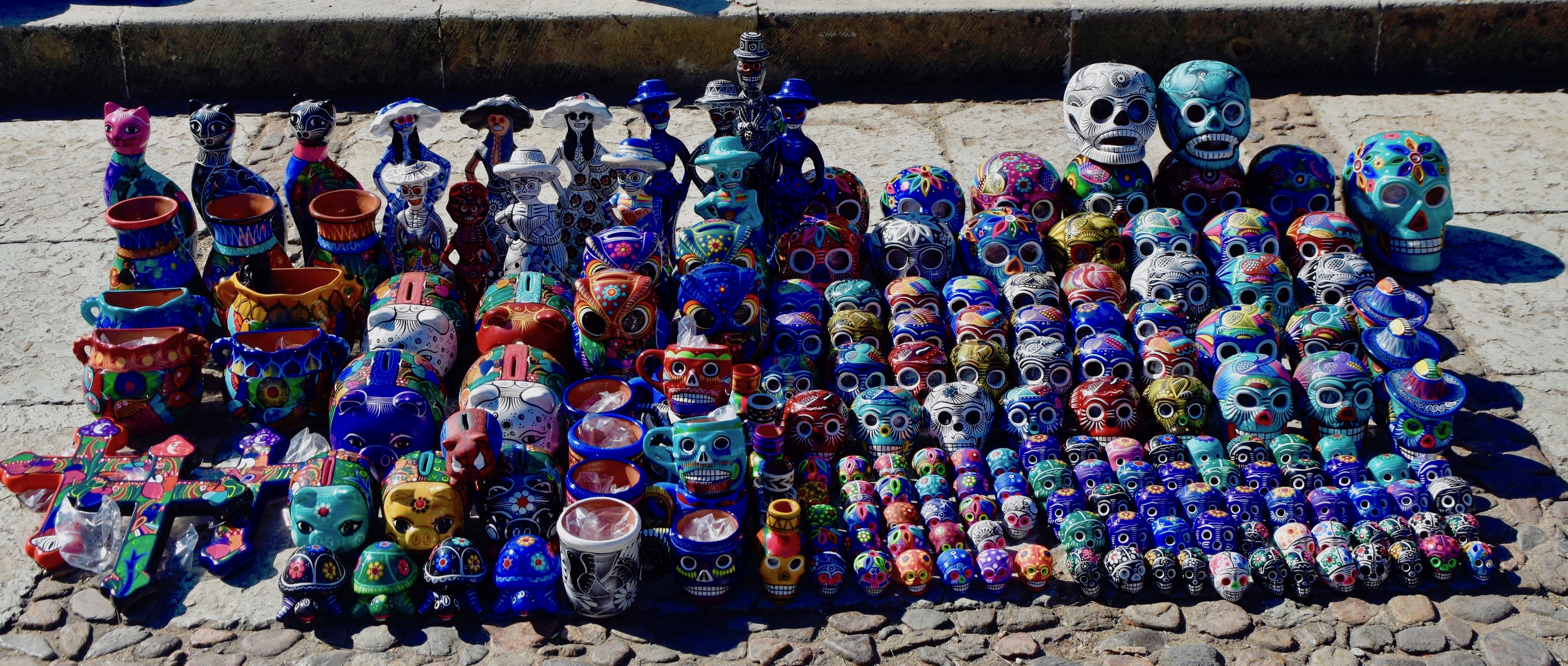
What Exactly is the Day of the Dead?
This question is more easily answered by starting with a list of things that the Day of the Dead is not, starting with the fact it does not take place on one day, but over many. During the entire time we were in Mexico there were activities associated with these celebrations going on in every place we visited. The second thing to know is that it has nothing to do with Halloween.
Whereas Halloween was, until recently, a time of fear and dread, the Day of the Dead is a time for the living to commune with and celebrate those who have died by sharing food, drink, music and memories. Despite the manifold references to skeletons, skulls etc. it is not a scary time, but a joyous one. Also, there’s definitely no trick or treating.
Lastly, despite the fact it coincides with the Christian Allhallowtide of Oct 31-Nov 2, it is decidedly not a Christian holiday but rather a syncretic one; meaning simply that existing elements of pre-Columbian religions, particularly the Aztec or Mexica have blended with some Christian traditions to create something that is unique. For me, it was this syncretic element that made the Day of the Dead so fascinating and something I just had to see.
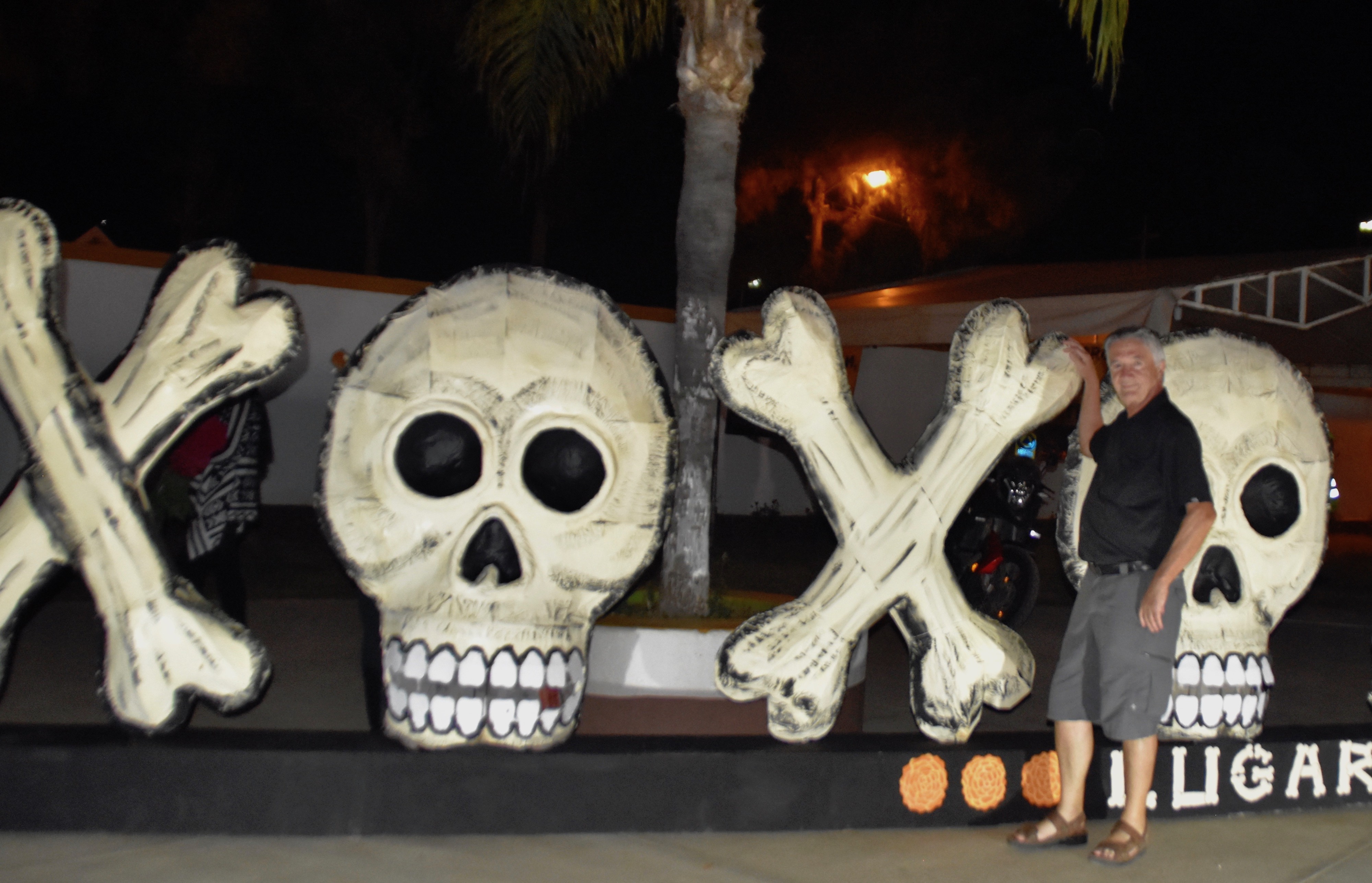
There are a number of elements that, in combination, create this mishmash of culture and religion that we call the Day of the Dead. These includes the building of ofrendas, altars built by families to commemorate their loved ones, the celebration of the Catrinas, the skeletal upper class ladies dressed to the nines, the preparation of and feasting upon special foods, all variety of parades, some planned and some spontaneous and finally the overnight vigils at the cemeteries that take place on Oct. 31 and Nov. 1. I’ll examine each of these elements in turn.
Day of the Dead Ofrendas
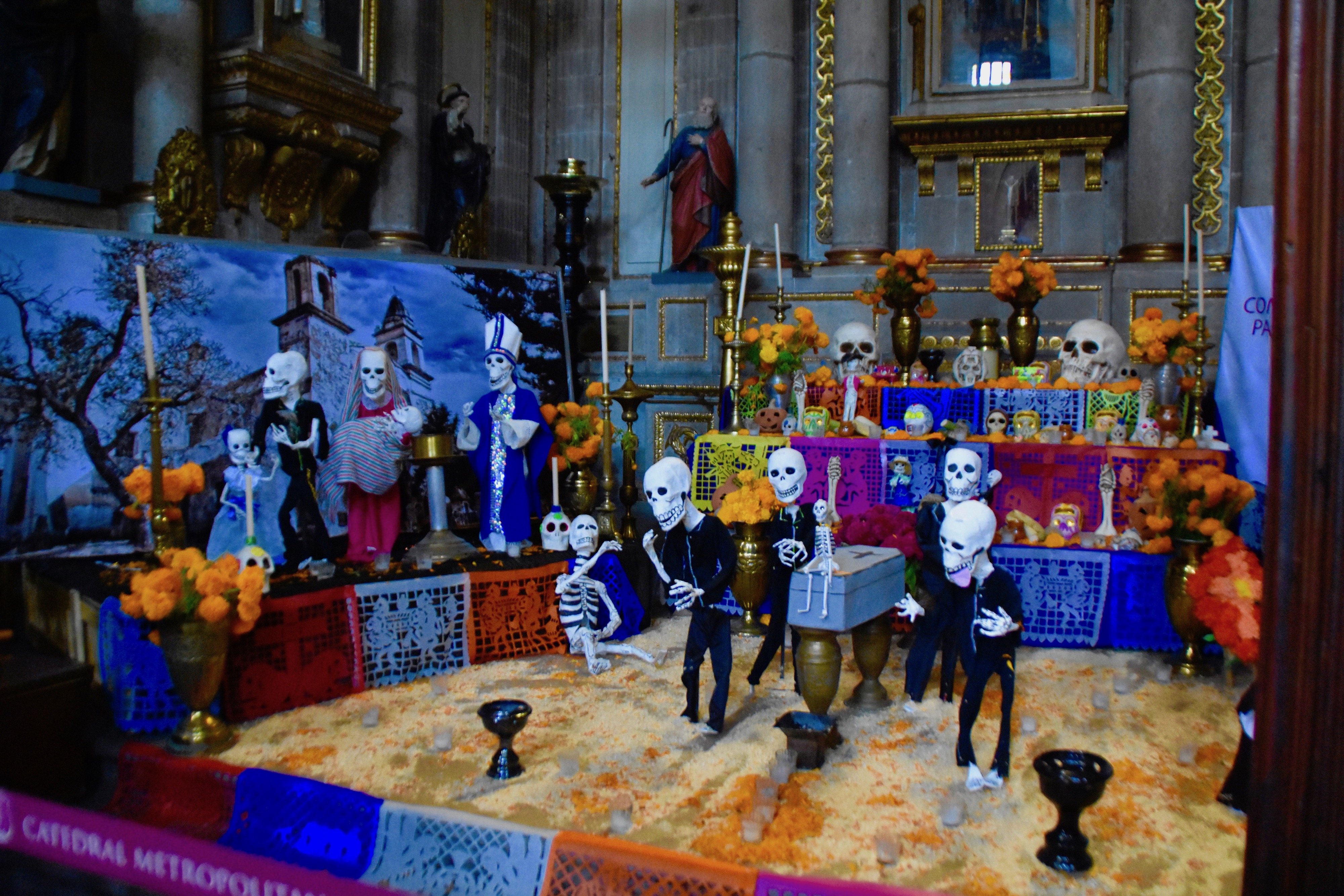
Ofrendas are perhaps the most essential element of the Day of the Dead and whereas the manner of the celebration might differ from state to state or even from one town to the next, the ofrenda be at the centre of all of them.
The ofrendas come in a number of varieties, including those built by churches and other institutions. The photo above is the ofrenda built by the congregation of the Metropolitan Cathedral of Mexico City, arguably the most important church in Mexico. It clearly demonstrates that there is a lot more going on here than traditional Catholic beliefs.
In addition to institutional ofrendas, virtually every business in Central Mexico builds one and decorates the place with papel picado, which are colourful cut outs featuring, what else, skeletons and such. You can see them in the photo above. In the photo below I’m seated in front of the ofrenda at the Sanford’s in Coyoacan, a popular store and restaurant chain in Mexico.
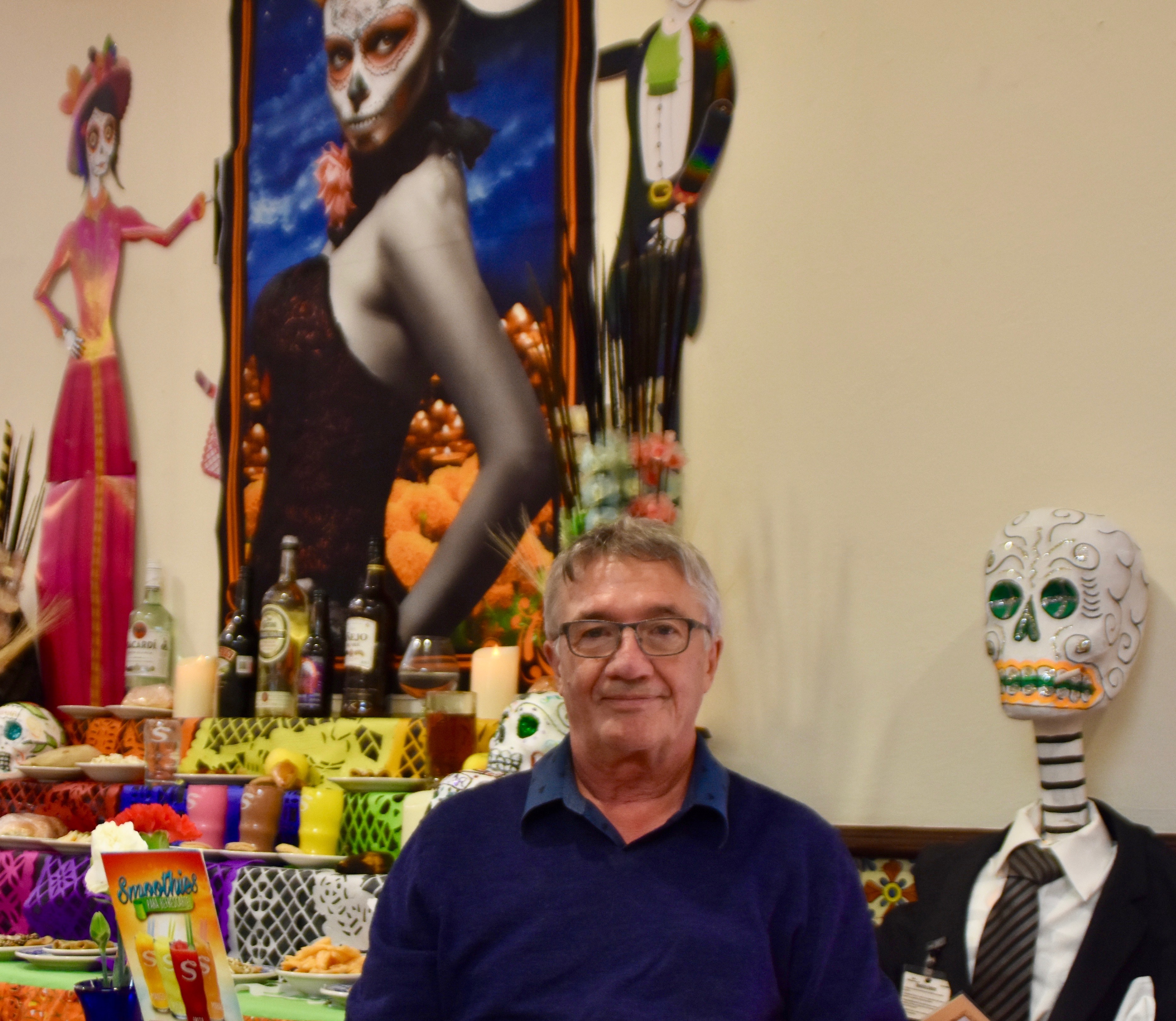
Then there are the ofrendas built by individual families in honour of, in this case, deceased parents. These usually contain mementos and photos of the honourees as well as their favourite items of food and drink. These type of ofrendas illustrate most clearly the belief that on the two days that are the highlight of the Day of the Dead celebration, the living will truly commune with the dead who are, in spirit, resurrected for the occasion.
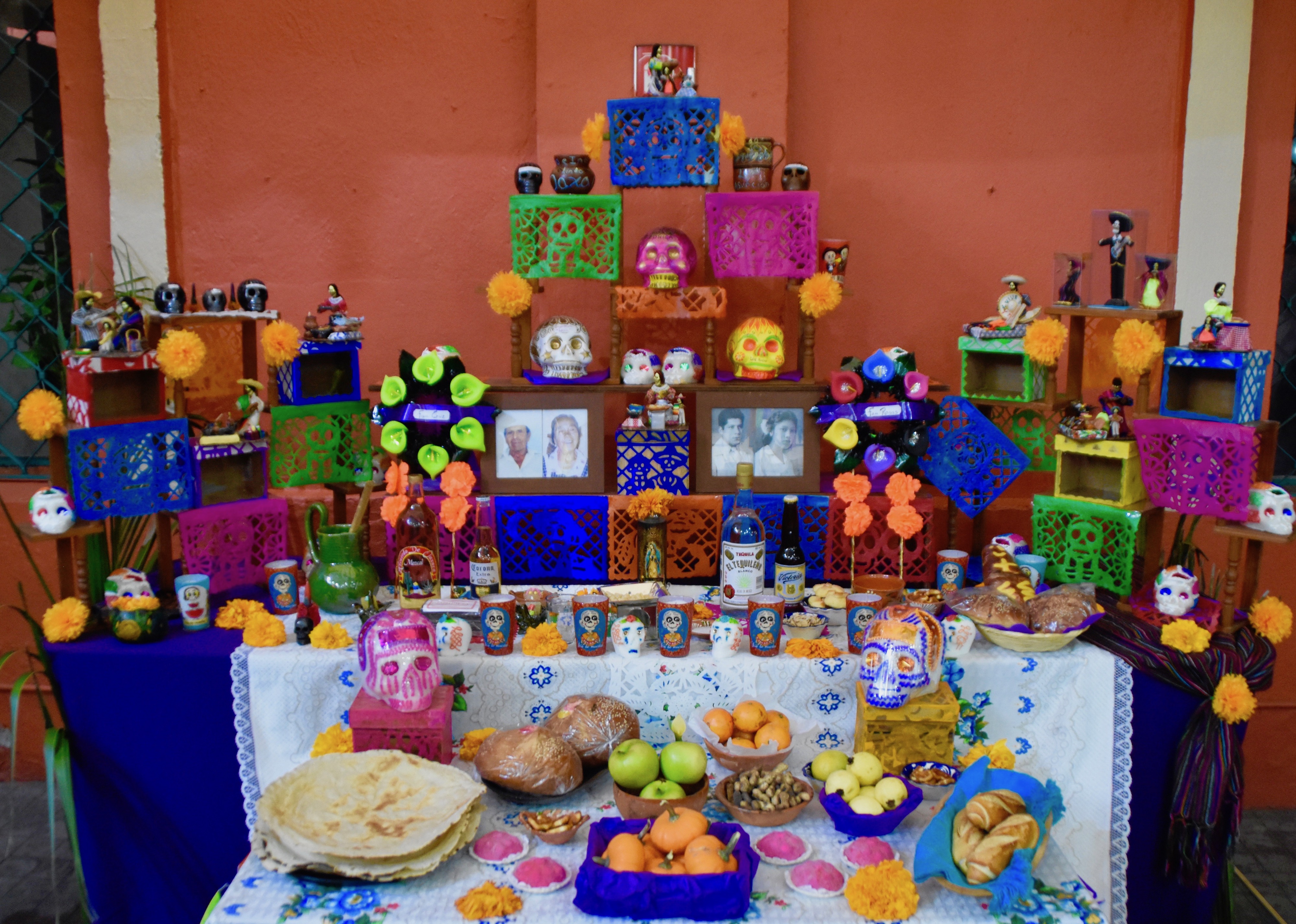
Finally there are the ofrendas that are built at the grave sites themselves and where the overnight vigils take place. Here is a fairly elaborate one for a young man who died at only 28
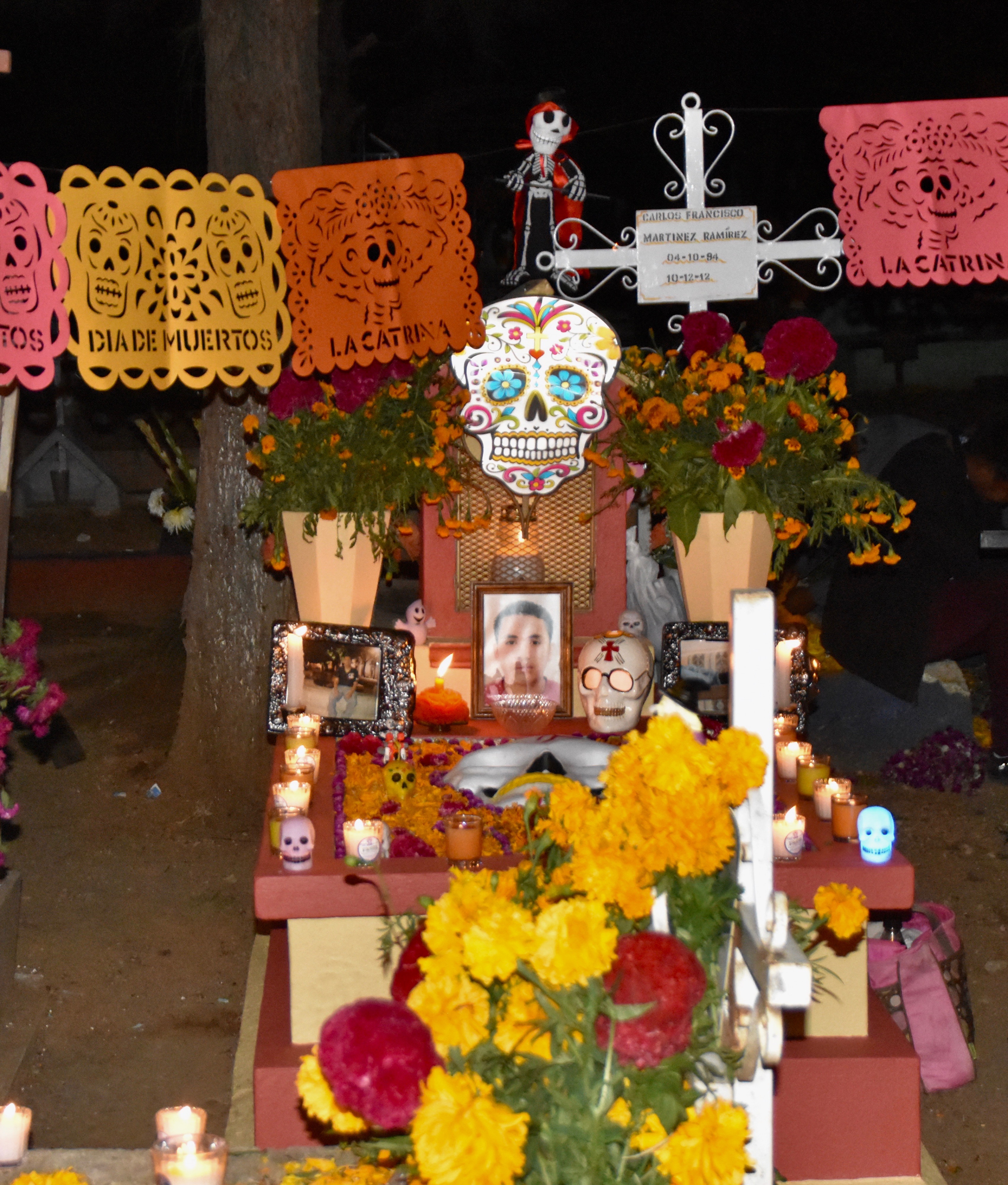
The building of the ofrendas can be as much a part of the Day of the Dead activities as any other aspect and it involves a great level of skill and imagination. These two gents are working on the ofrenda at the archaeological site of Monte Alban, just outside Oaxaca.
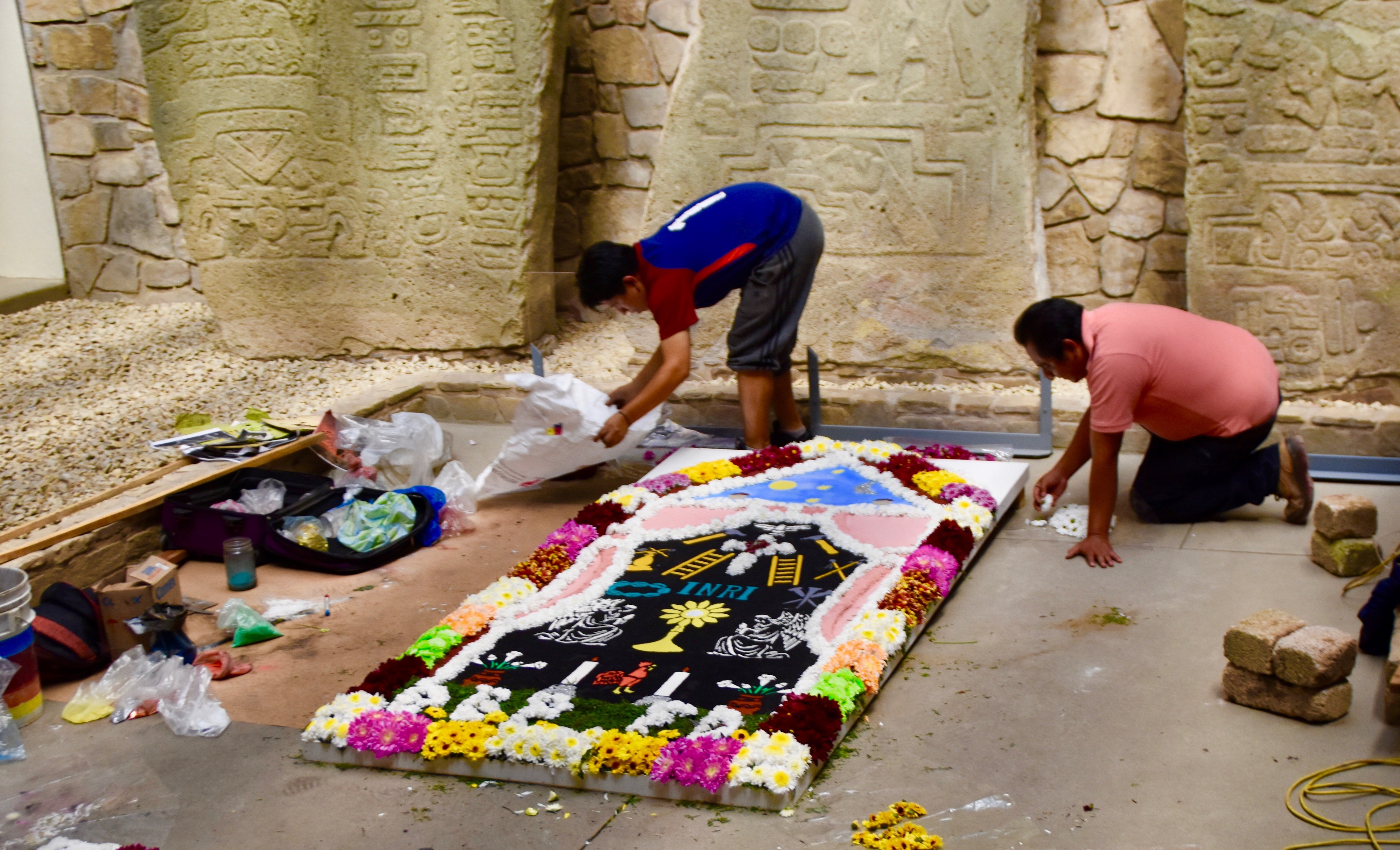
It’s also a family affair and I can’t help but think that Mexicans learn at a young age that death is the inevitable end to all of us and is not to be feared, but is merely a transitional phase from one state of being to another, whatever that might be.
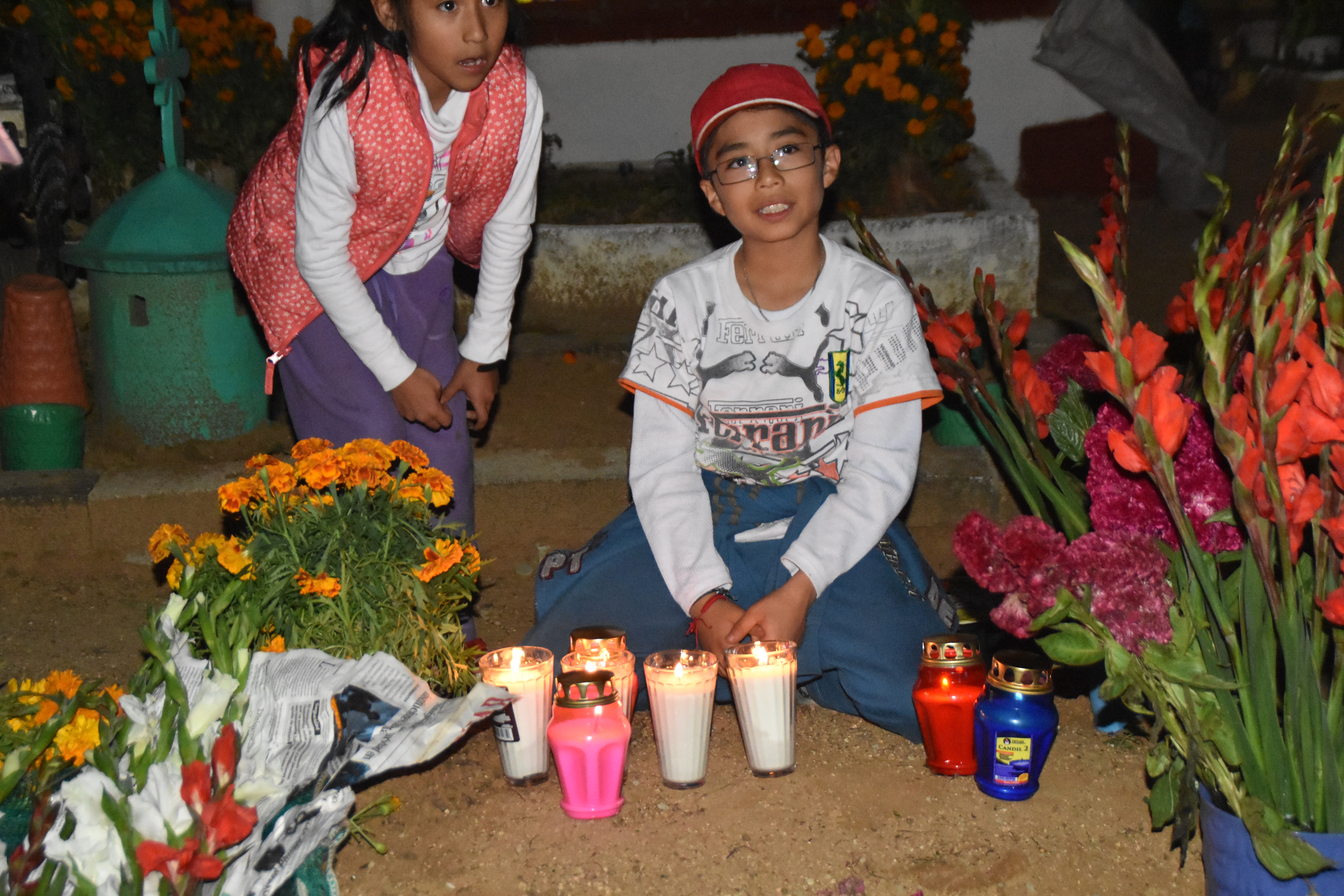
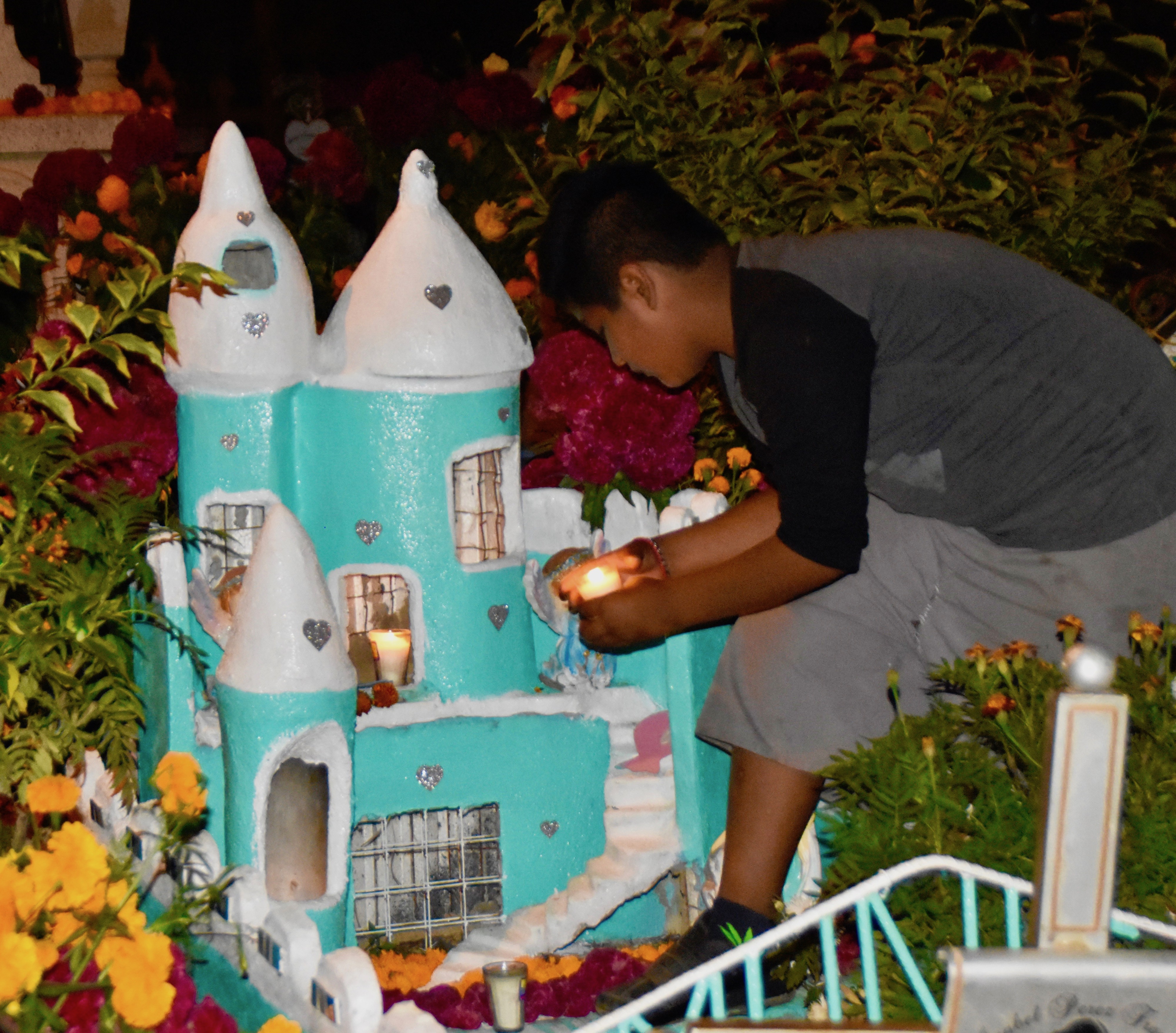
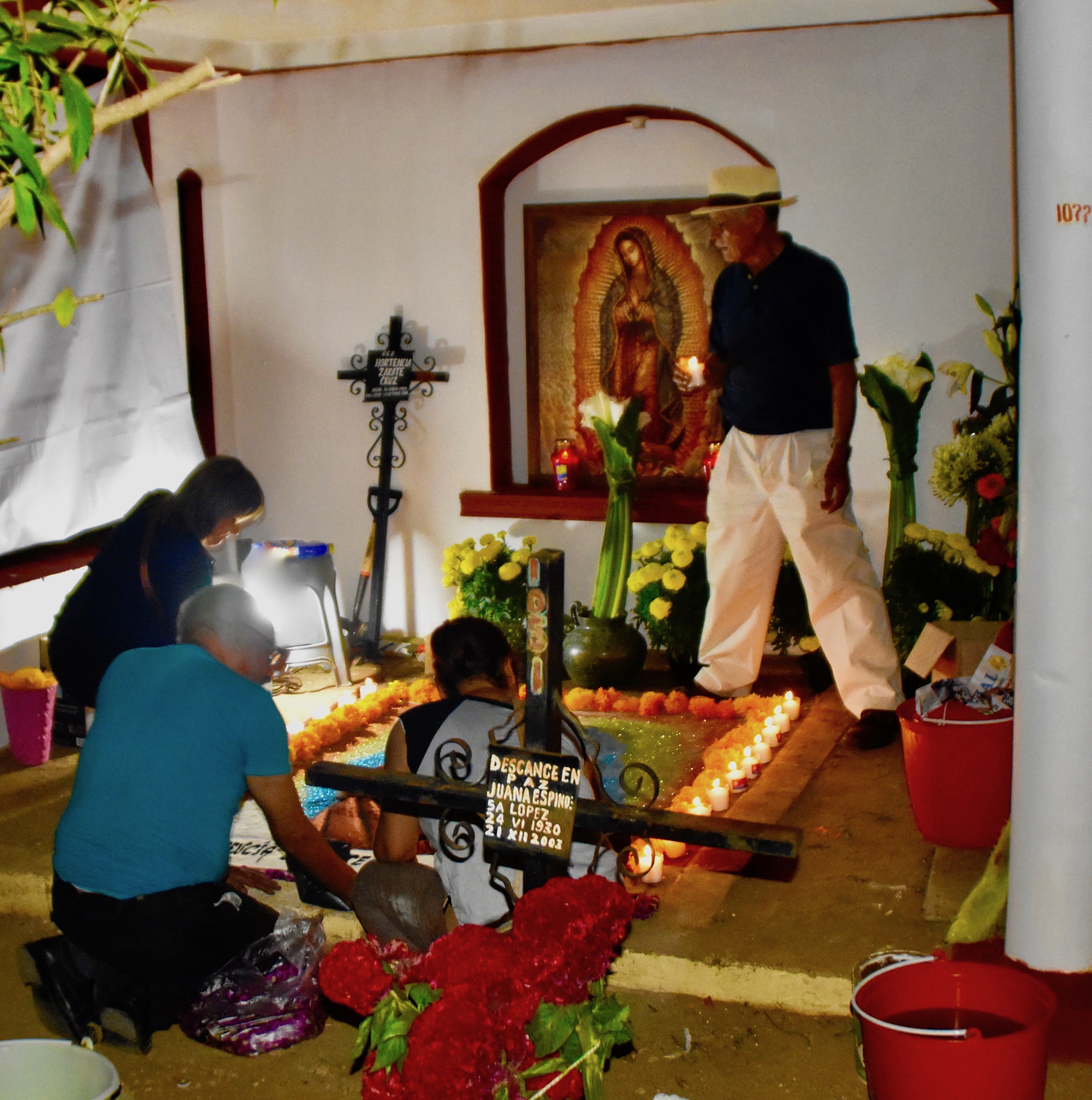
Day of the Dead Catrinas
If there is one image that outsiders would probably be most familiar with it’s the skeletal upper class dame known as a Catrina which is almost as omnipresent as the ofrendas. This huge one was erected inside the Guanajuato Granary, one of Mexico’s most historically important buildings.
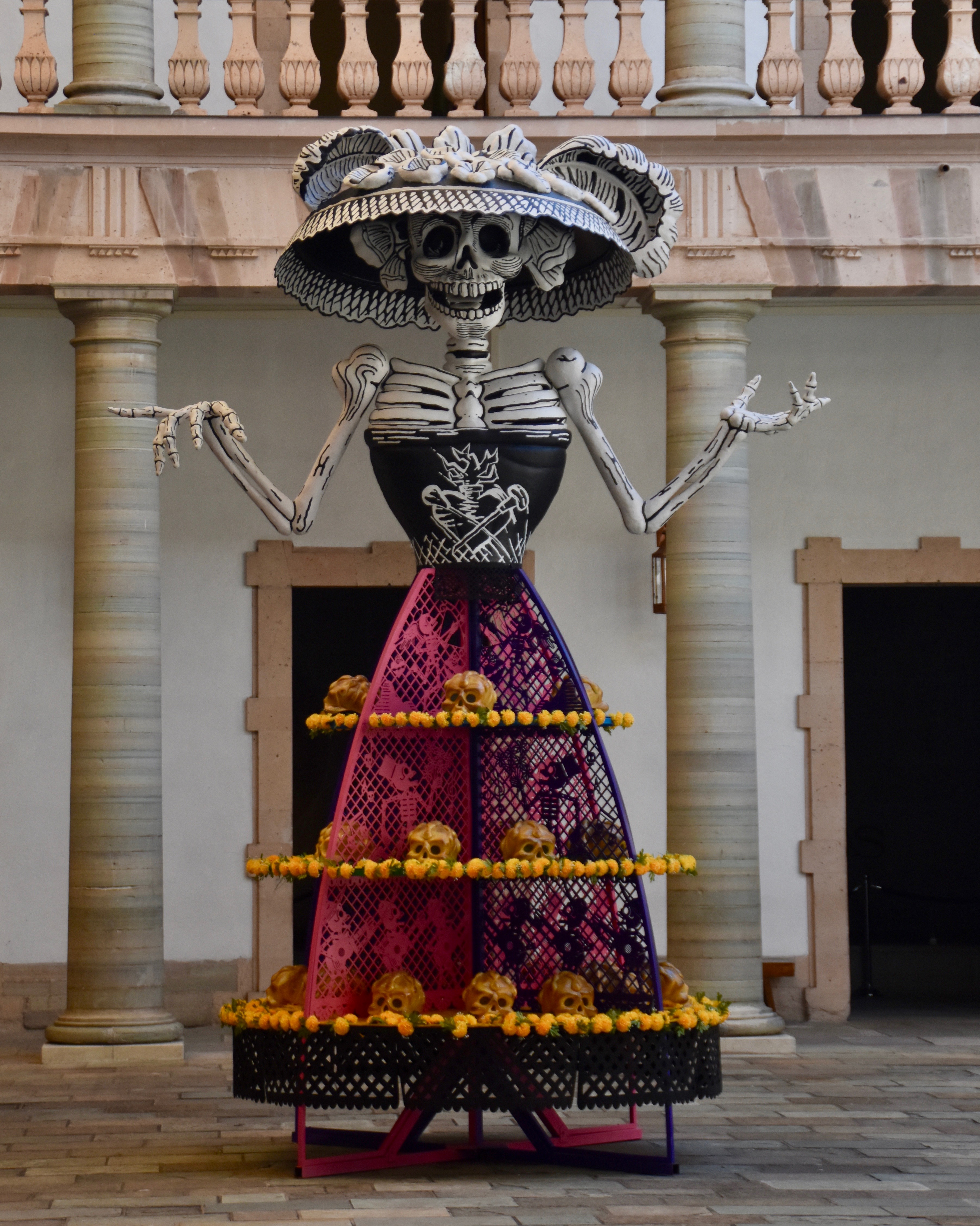
Yet, surprisingly Catrinas date back to just over a century ago when the first image of one was drawn by Mexican artist José Posada. You can see that the Guanajuato Catrina is very closely modelled on this first depiction.
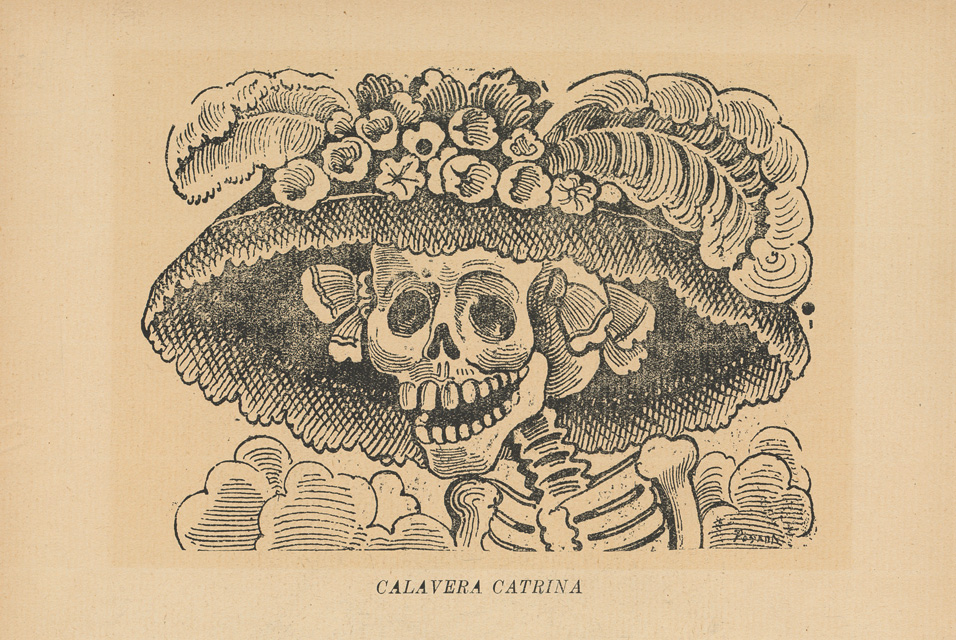
Catrinas are in fact figures of fun, satire and contempt. They are meant to represent women and increasingly their male companions, who won’t admit to or embrace their Mexican heritage, but rather put on the airs of a European.
In other words, they are stuck up bitches, but they’re the only ones who don’t know that. One popular story is that they are meant to represent upper class Mexican women of pure Spanish descent who returned to Spain to give birth to their children so they would be Spanish citizens.
Catrina dolls are everywhere and I doubt many tourists escape Mexico without one. We didn’t. Actually, the little ones make great souvenirs and gifts.
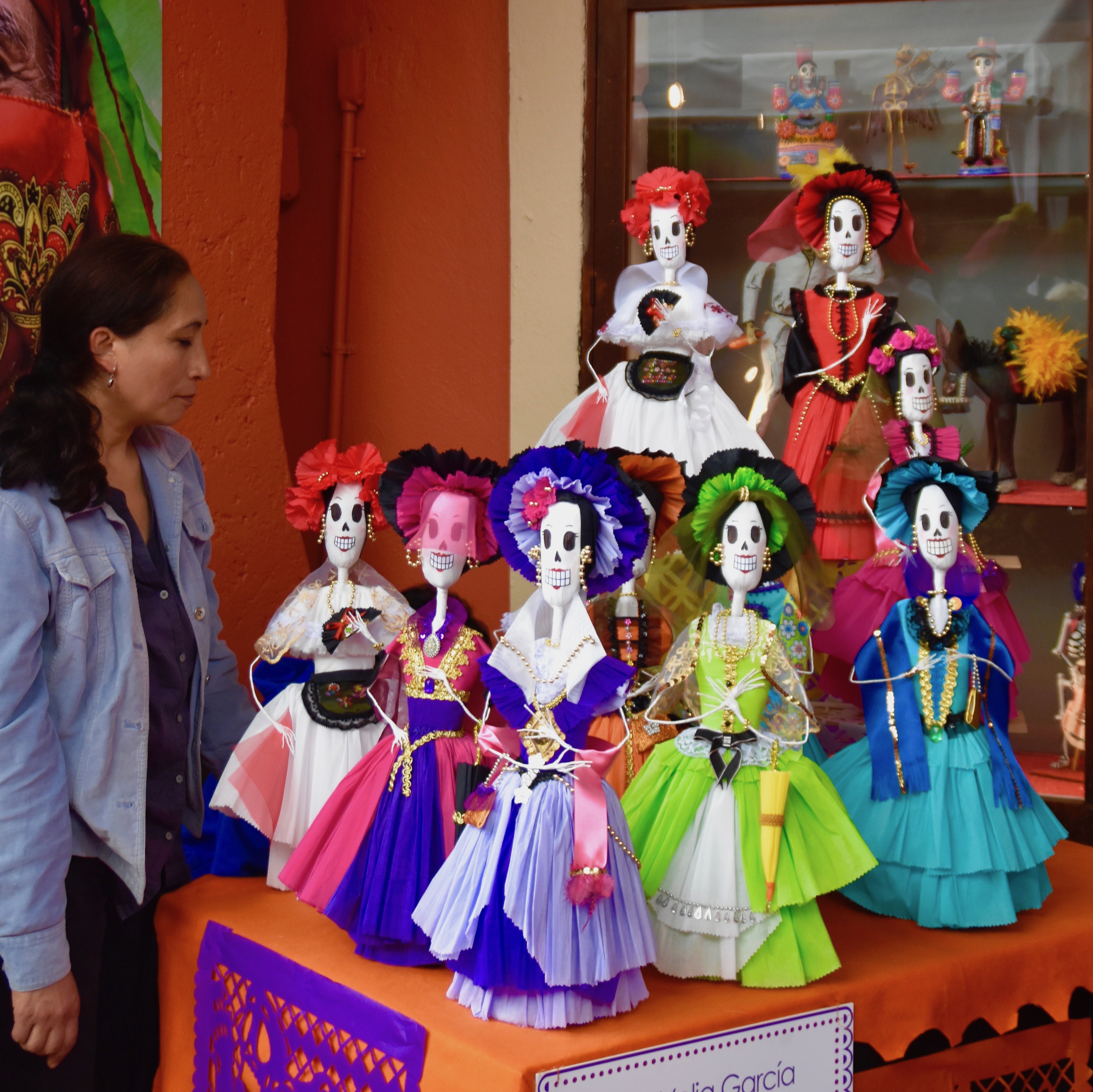
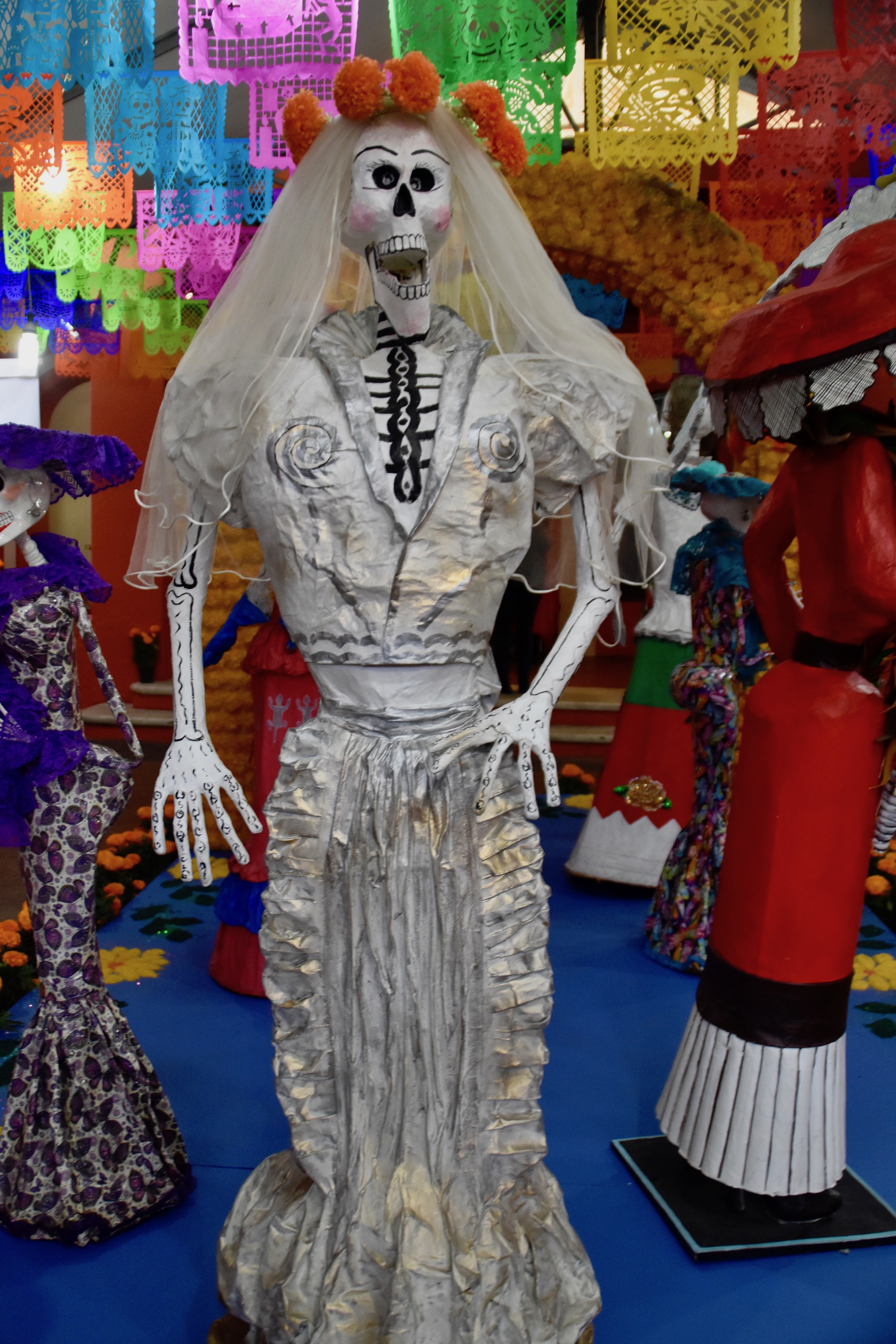
Day of the Dead Special Foods
One hallmark of every special occasion in every country and culture in the world is the preparation of food and drink that is directly associated with the festivity. Think no farther than hot cross buns and Easter. The Day of the Dead is no exception.
Pan de muerto are special sweet breads that have what can be incredibly intricate face known as a carita attached to the centre.

Most of the caritas depict religious figures, particularly the Virgin Mary, but I also saw lots with skulls and a few other non-Christian symbols.
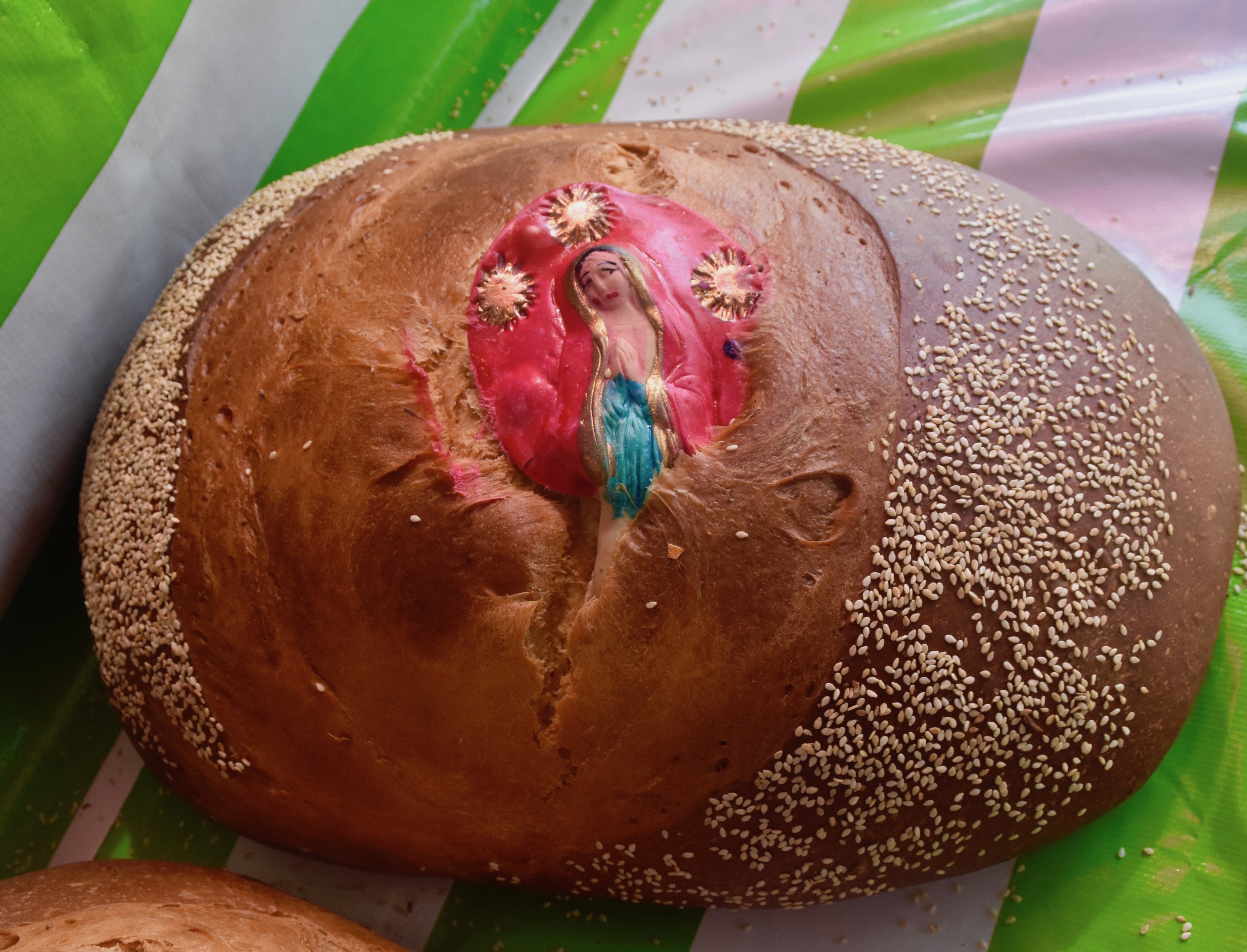
One of the reason children aren’t afraid of the Day of the Dead events is surely that they get to eat a shit load of candy – candy made of almost pure sugar. I saw a lot of overhyped kids stuffing their mouths with these pretty, but dietarily deadly confections.
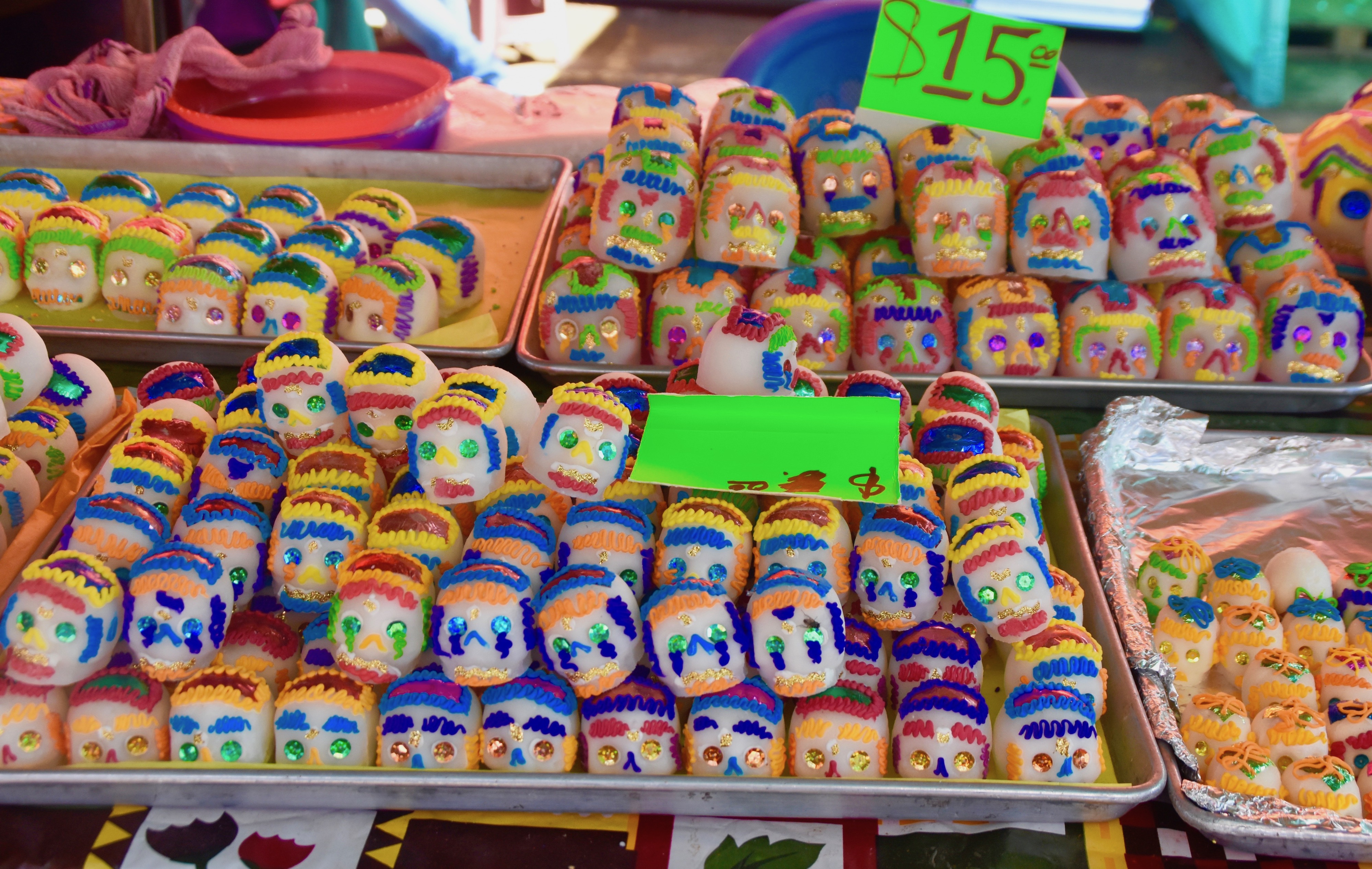
Here’s a vendor of more traditional marzipan in the shape of fruits and vegetables. Lovely to look at, but awfully hard to eat.
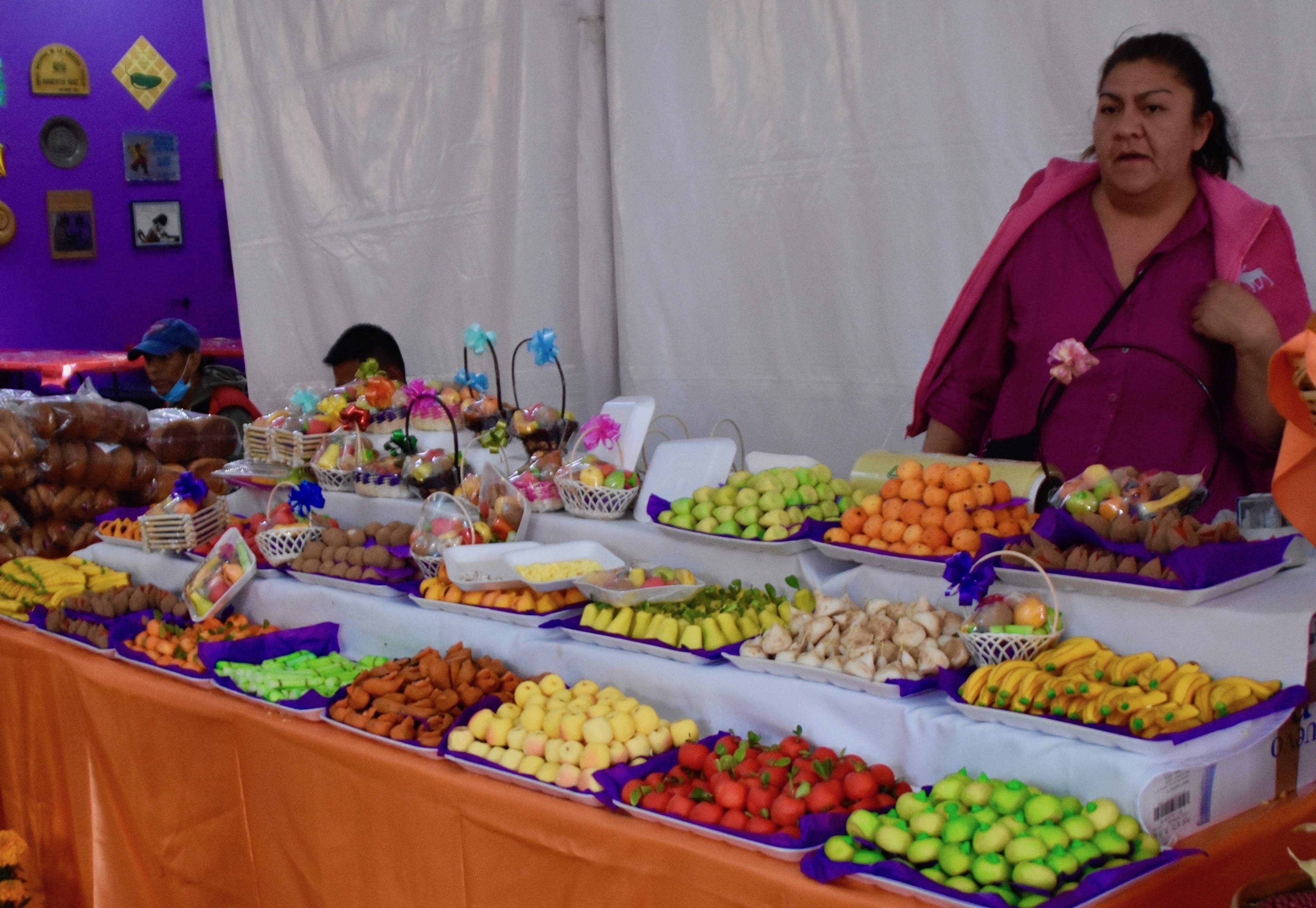
Some things are perhaps best left to the imagination, including pulque a sweet, fermented alcoholic drink often consumed during the Day of the Dead period. It was described in one article I read as ‘looking like semen with the texture of boogers’.
However, the writer went on to say that it had the taste of pure magic. Unfortunately, I couldn’t overcome the first two adjectives so stuck to Victoria beer and good tequila and mezcal for my refreshments.
Day of the Dead Parades
Everybody loves a parade, right? And none more so than the Mexicans during the Day of the Dead. They love to watch them and they love to participate in them. There are Catrina parades, kids parades, parades with fireworks and spontaneous parades around a cemetery.
Technically not parades in the traditional sense of the word, these gatherings of local people dressed in costume and dancing to music are called comparsas and you can watch them or join in the fun if you want to.
On our very first day in Mexico City we got stuck in traffic because a huge Catrina parade was virtually blocking off the entire Centro Historico. The irony is that, in a perfect case of life imitating art, this particular parade was inspired by the James Bond movie Spectre.
In one of the most compelling openings to any Bond movie, Daniel Craig as Bond makes his way through a huge parade that never actually existed in Mexico City until one was set up for the movie. Mexico City residents liked it so much that they started their own Catrina parade the next year and the one we were blocked by didn’t look much different than what you see in the movie.
In Oaxaca, where we actually spent the two crucial days of the Day of the Dead celebrations, we saw many parades, but none cuter than the children’s parade which is just about to begin in this photo led by a little fellow with a wagon full of flowers.
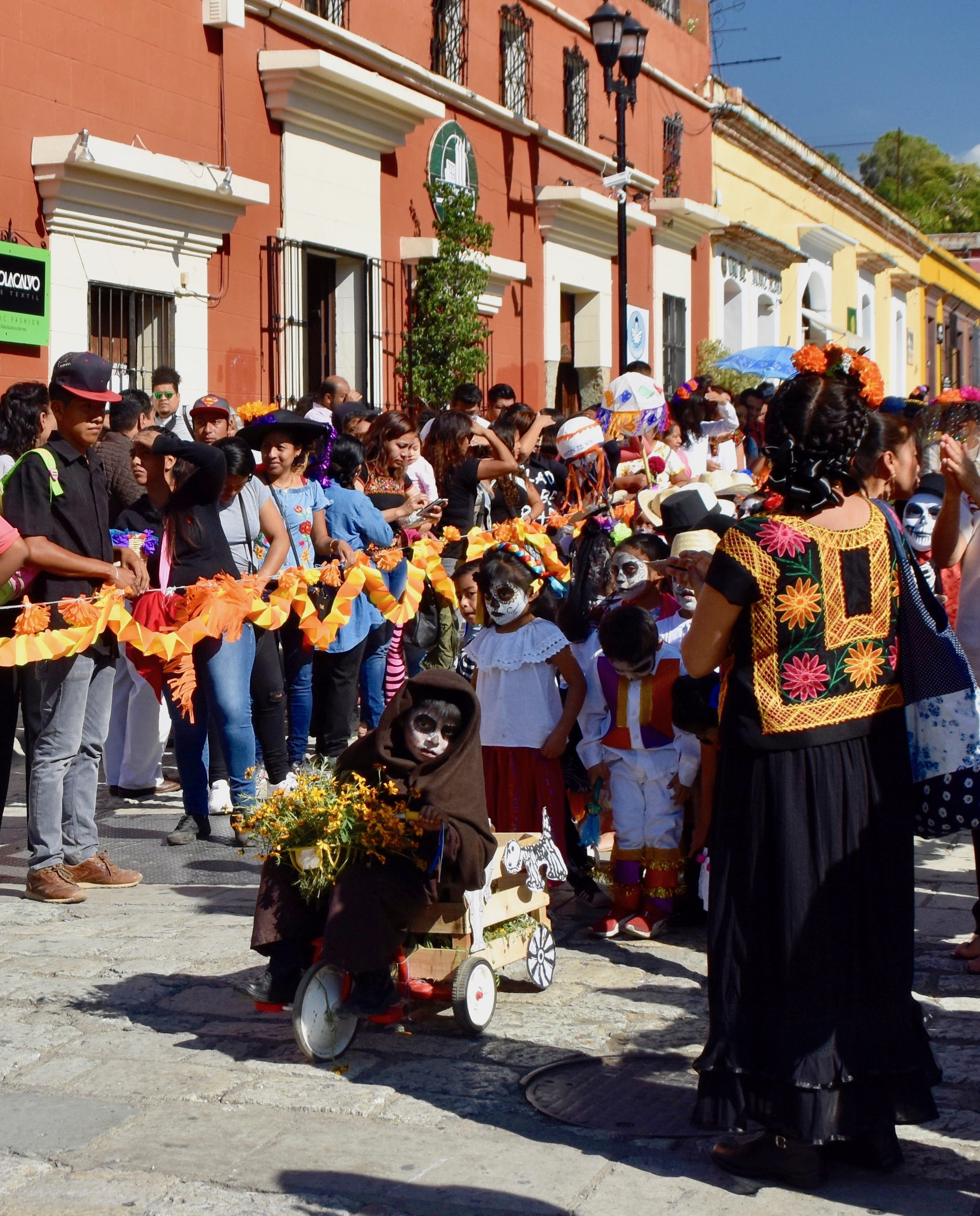
In warm up to the parade some of the children danced with their mothers in front of the Oaxaca cathedral. Sorry about the poor quality of this short video, but it gives you an idea of the gaiety of the Day of the Dead for the youngsters.
Each evening while we were in Oaxaca there was a comparsa that began just after sundown in front of the Santo Domingo cathedral and proceeded down the pedestrian Calle Macedonio Alcalá to the Zocalo. Here are a few photos from one of them.
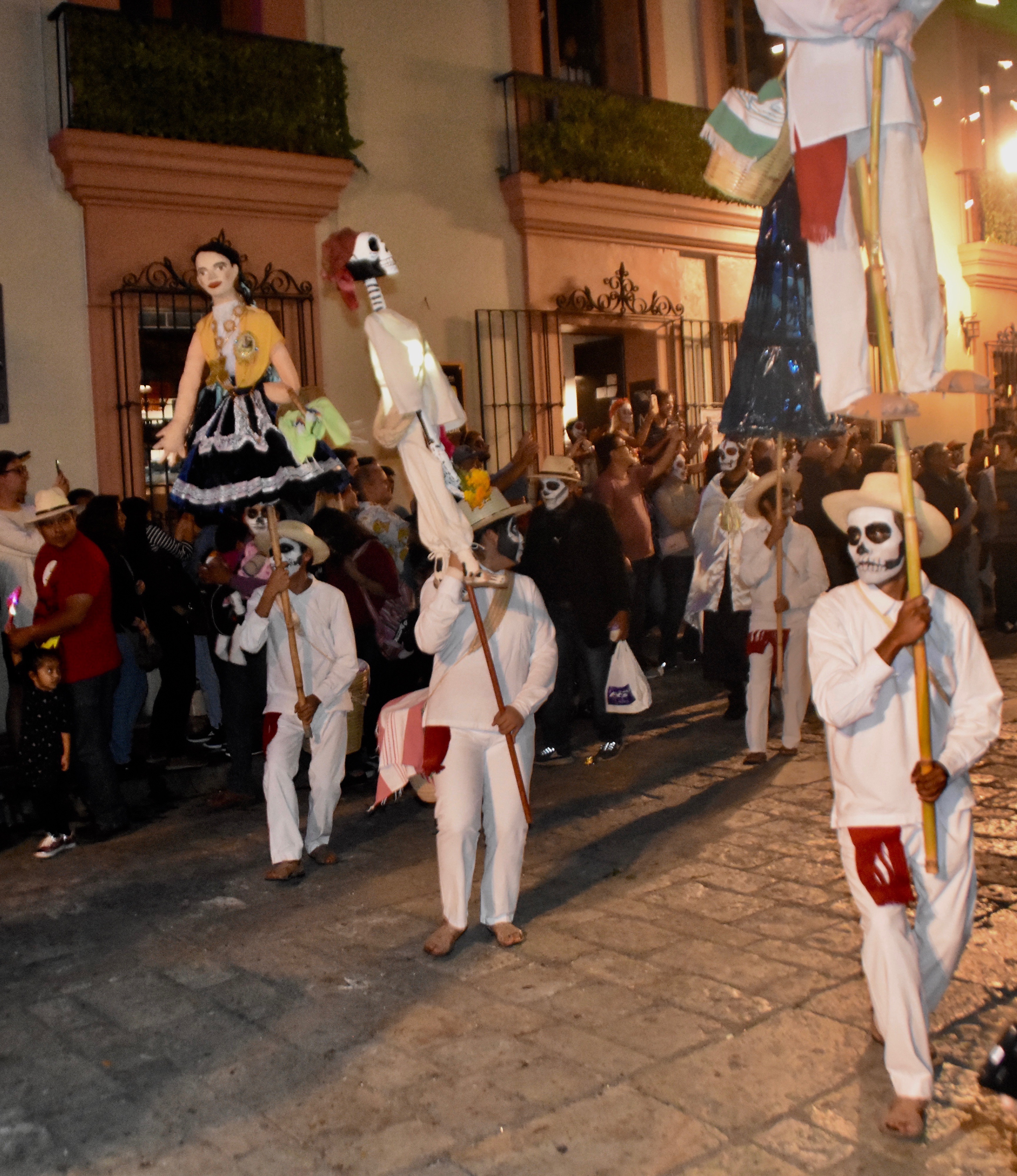
Fireworks are very much a part of a comparsa and you are bound to get more than a few sparks com ing your way.
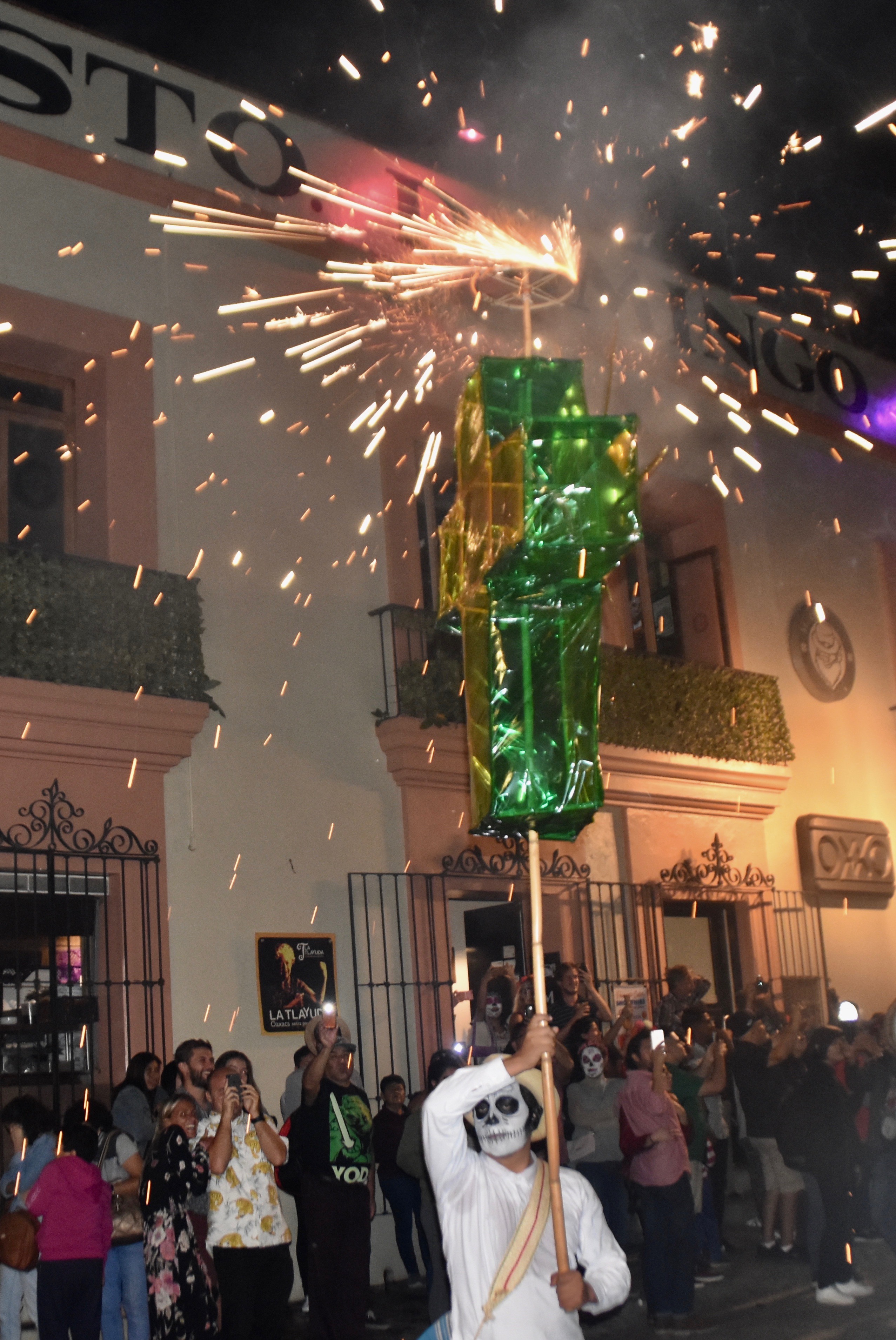
And so is music.
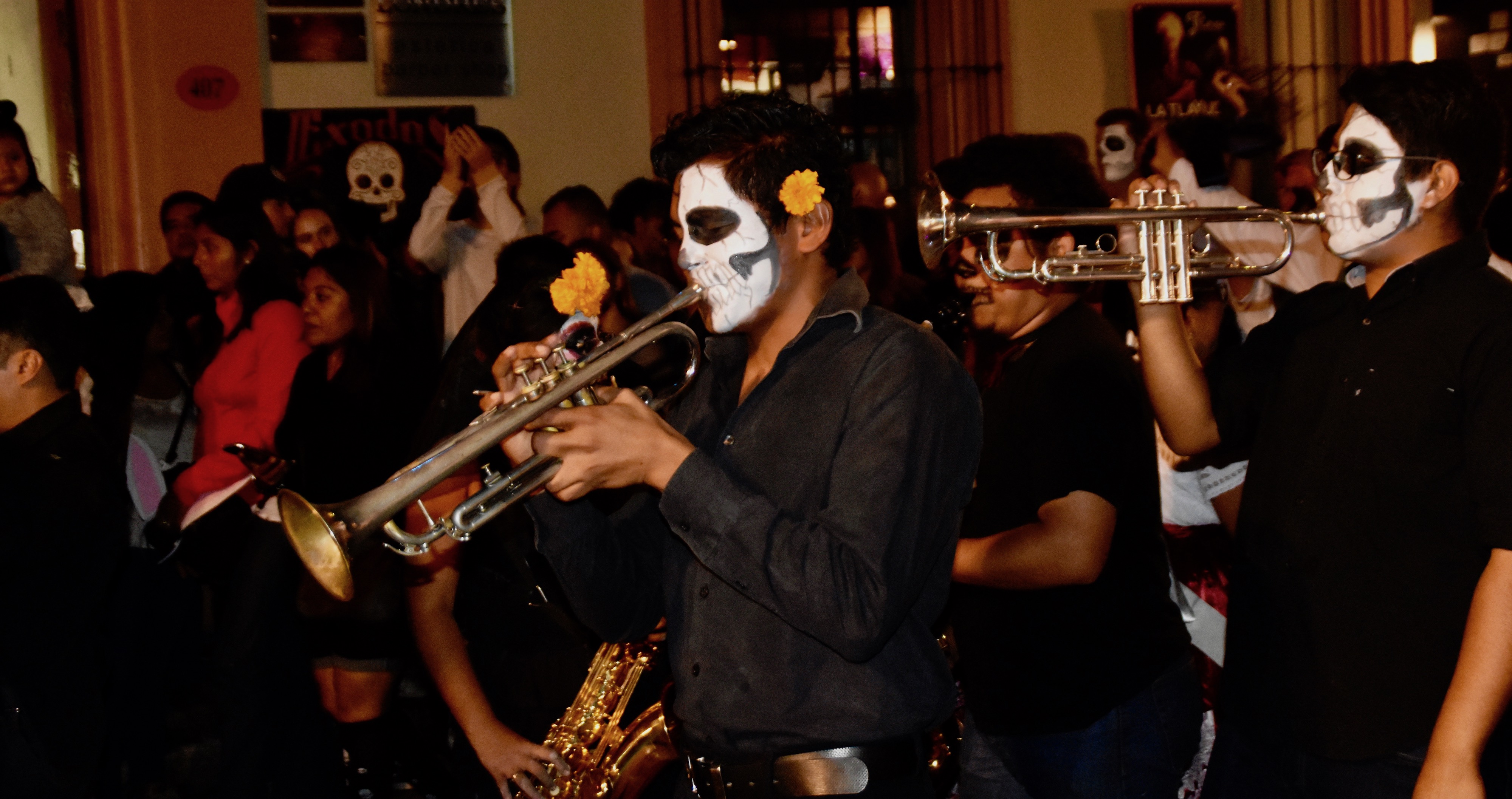
And dance.
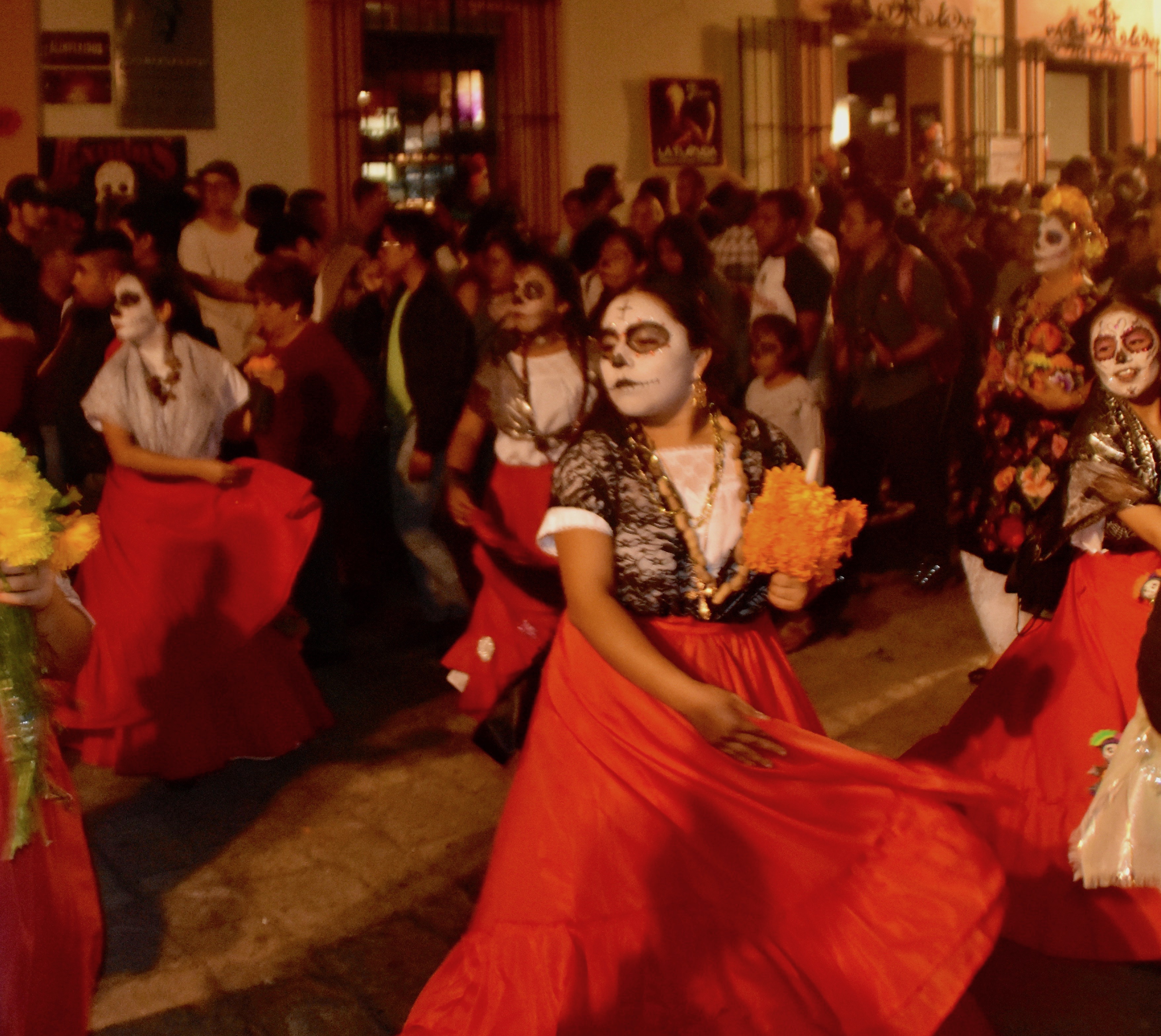
These really are spectacles that, to paraphrase Abe Lincoln, are by the people, for the people. A great majority of the onlookers were clearly not tourists, but locals who, usually with painted faces or in costume, would join the comparsa for a block or so and then rejoin the spectators. A few tourists were doing this as well, but I didn’t want to ruin the parade so remained an interested bystander.
Day of the Dead Cemetery Visits
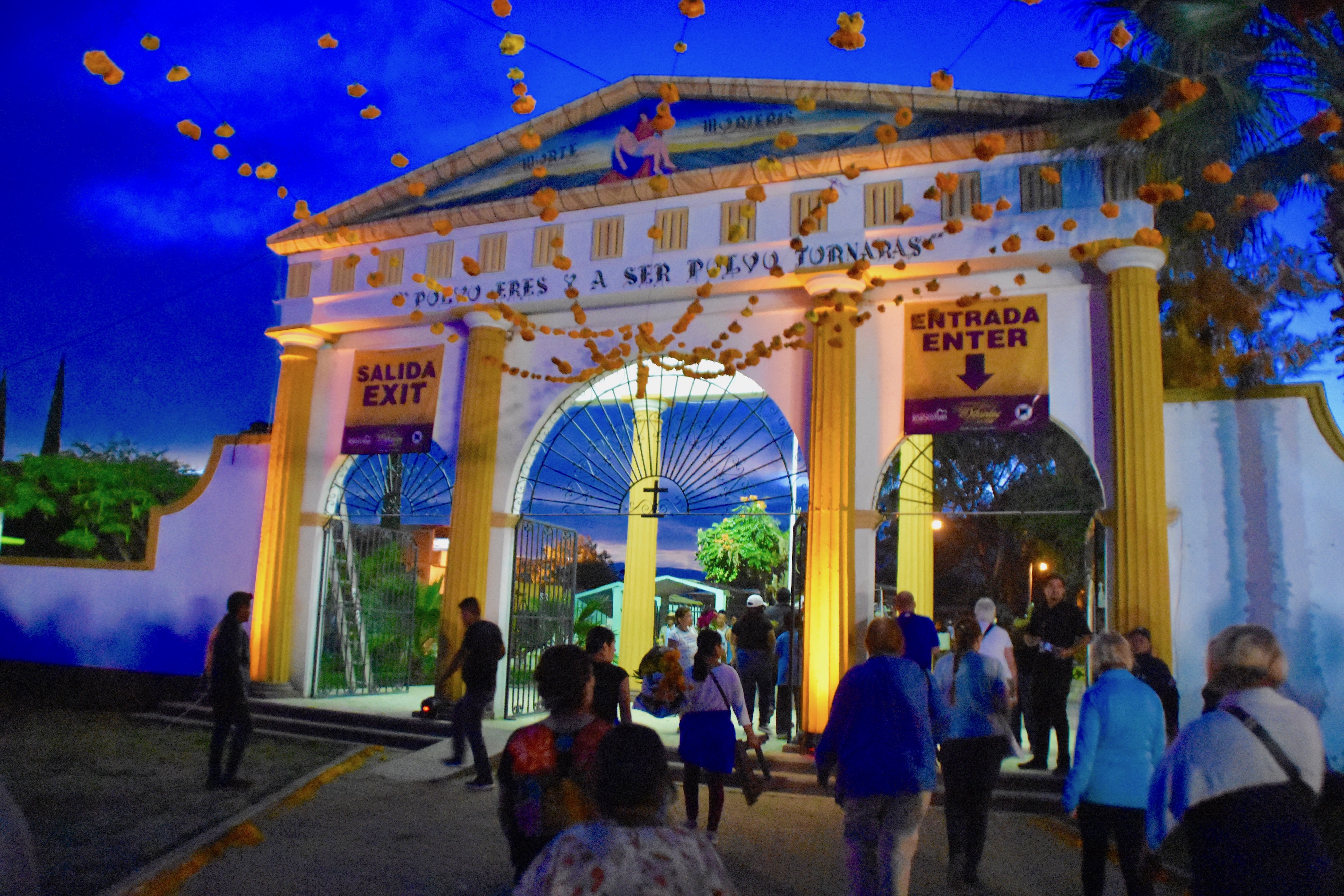
If there is one element that absolutely defines the essence of the Day of the Dead, it is the night time vigils that take place on October 31 and November 1 at cemeteries throughout much of the country. The October 31 vigils are to held to invite deceased angelitos (children) to return for a visit, while November 1 is for departed adults.
Our group visited two cemeteries in the small Oaxacan village of Xoxocotlan just outside the city proper on October 31. Like the comparsas, there were a few tourist groups around, but the majority of people were actual participants in the vigils or part of several makeshift bands that provided a lively background to the evening.
To say the atmosphere was festive rather than funereal would be a gross understatement. There were food and drink vendors, a few kids asking for candy or preferably pesos and the beautifully decorated grave sites, plus throngs of people.
In advance, I really questioned myself as to whether or not we would be nothing more than a ghoulish bunch of voyeurs inappropriately barging in to what were private family affairs. However, Victor assured me that the local people welcomed visitors and he was absolutely correct. We were warmly welcomed and no one objected to the taking of photos, although I tried to refrain from being too intrusive. Here are just a few of the many photos I took at the New Cemetery.
Several family groups had musicians playing specifically for their vigil site.
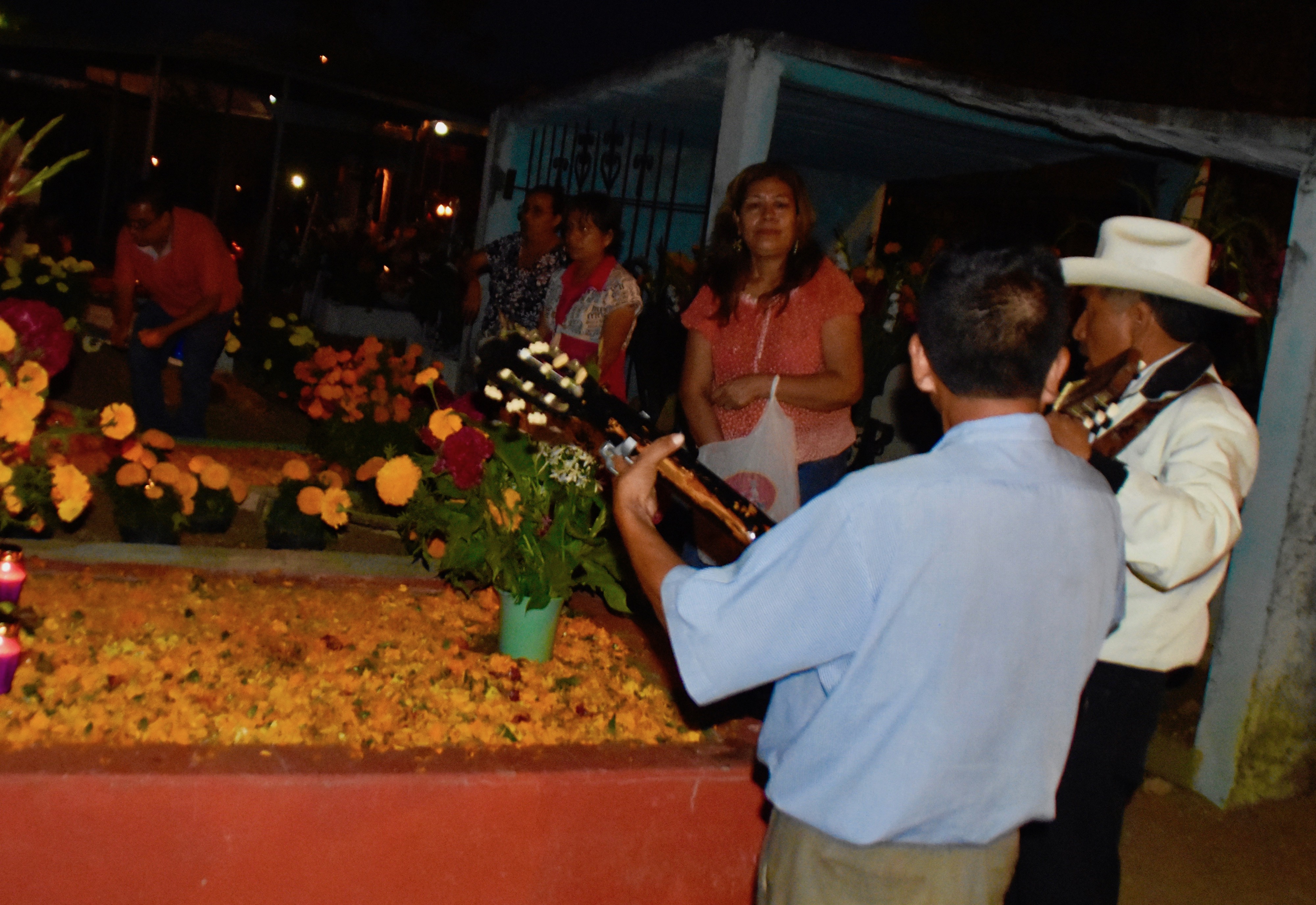
One of the traditions associated with the Day of the Dead is to place a mound of earth over an existing grave to give it the appearance of being freshly dug, thus creating the atmosphere that the deceased has not been gone that long.
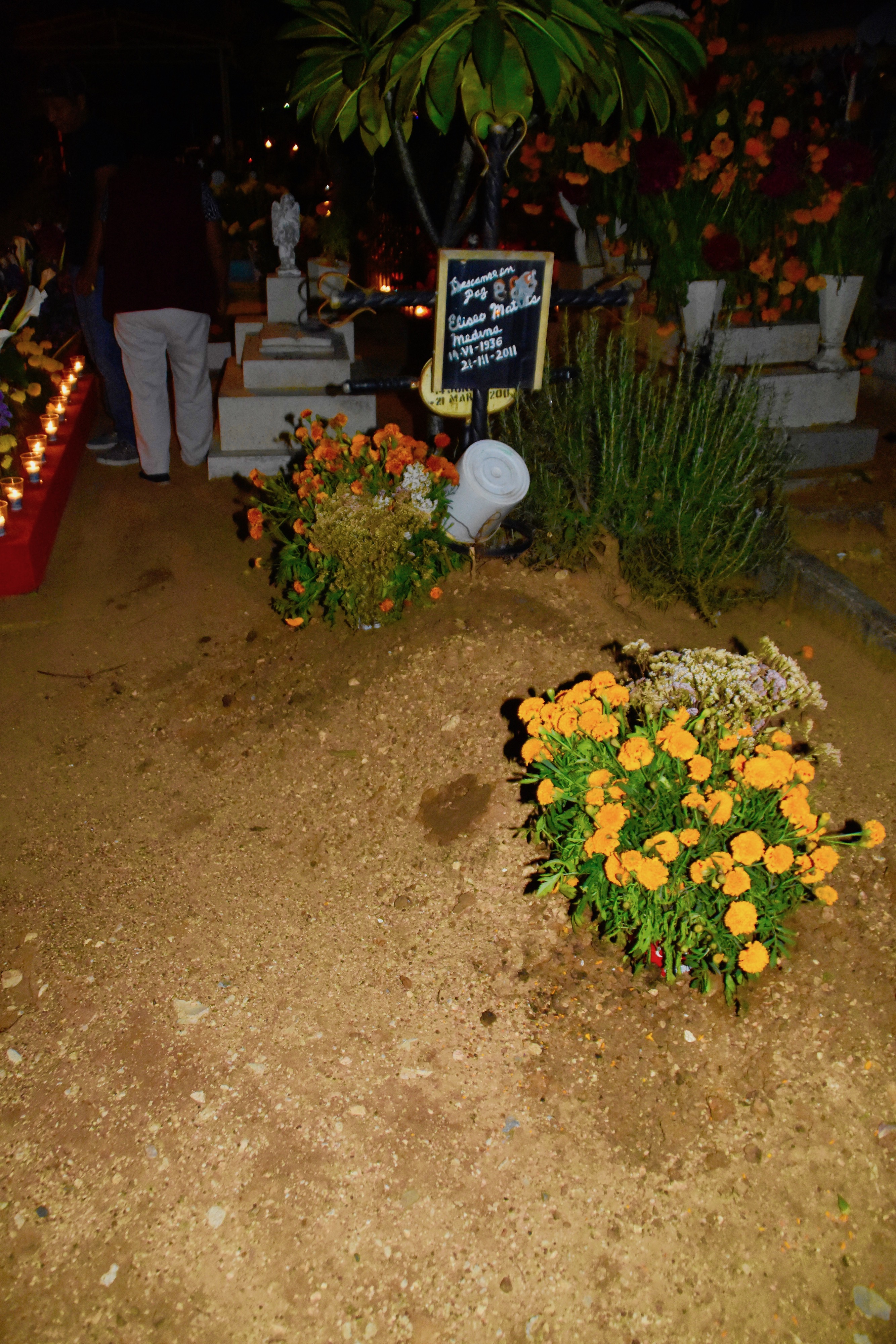
The variety and beauty of the cemetery ofrendas is amazing.
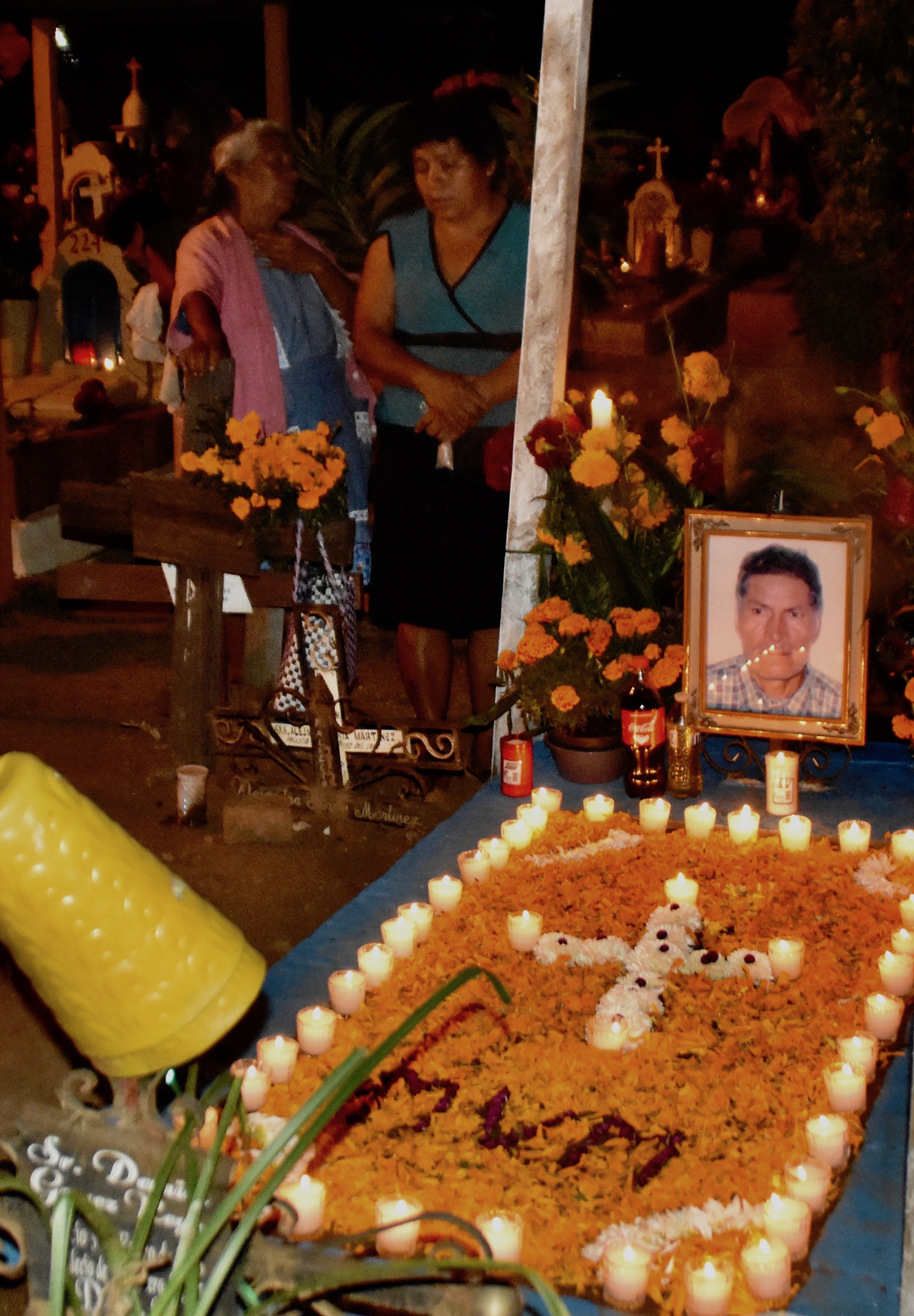
This widow communing with her husband has created a tapetes de arena (sand tapestry) as her ofrenda, which is yet another custom associated with the Day of the Dead.
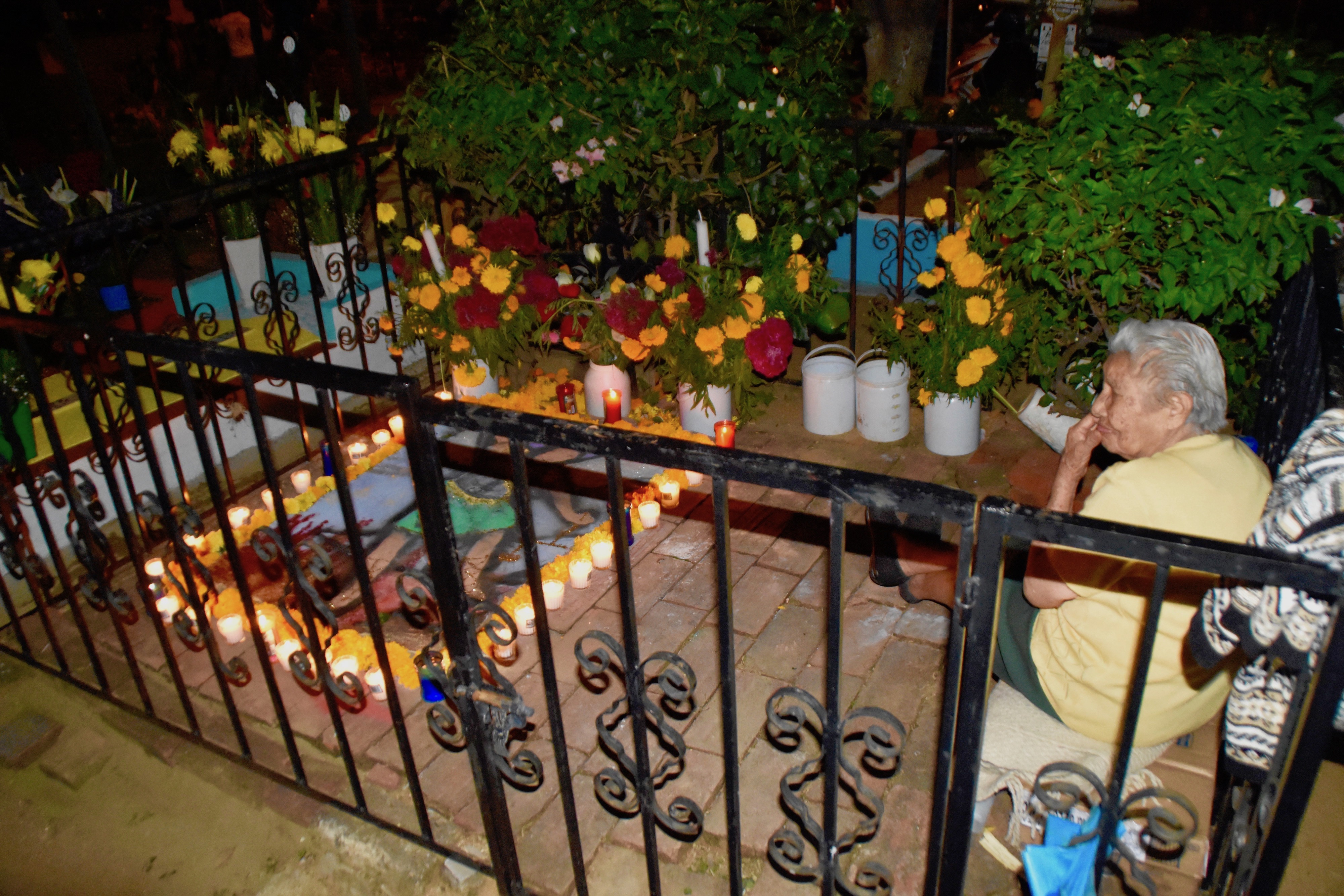
October 31 is technically the night of the angelitos. This is an ofrenda of one such little angel. Usually nothing is more tragic or gut wrenching than the death of a child and one would intuitively think that bringing back the memory of whatever led to the death would be a very sad occasion. Not so on this night.
We saw many gatherings around the graves of dead children and I didn’t see one person crying or being consoled. It’s one of those things you have to experience to get even an inkling of how different the Mexicans view death then we do in Canada and the U.S.
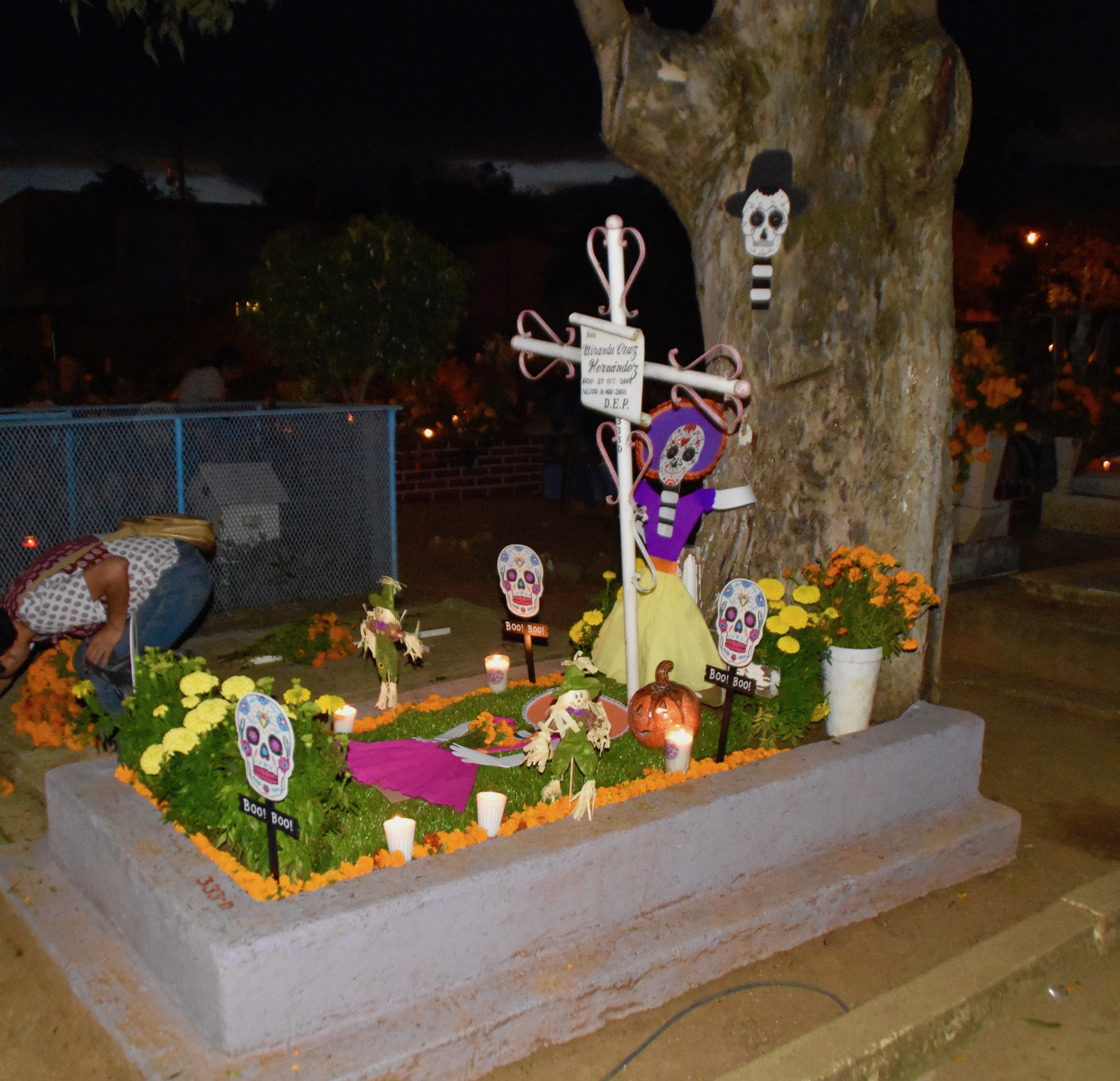
Just outside the gates of the New Cemetery there was a collection of very well done sand tapestries.
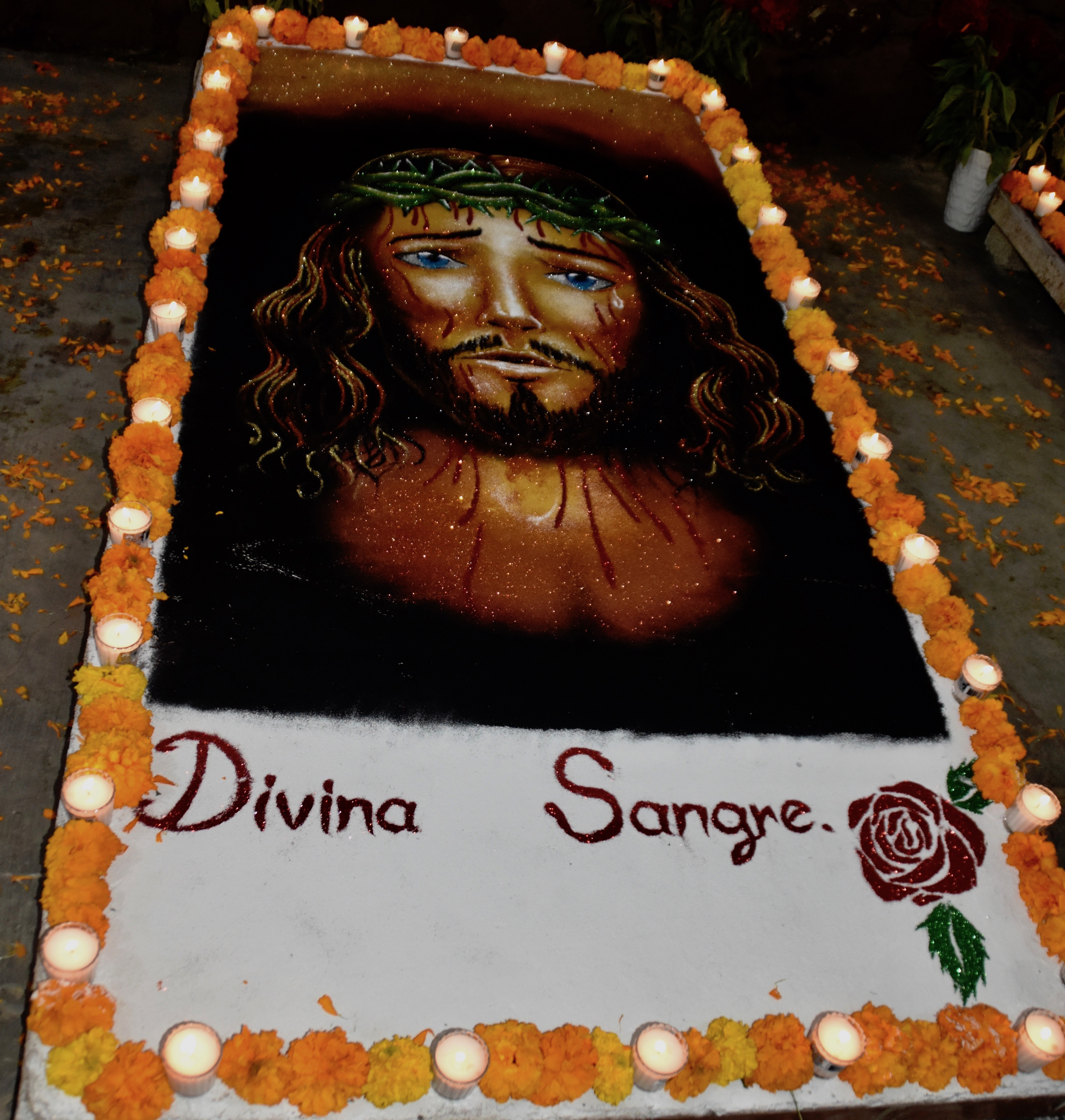
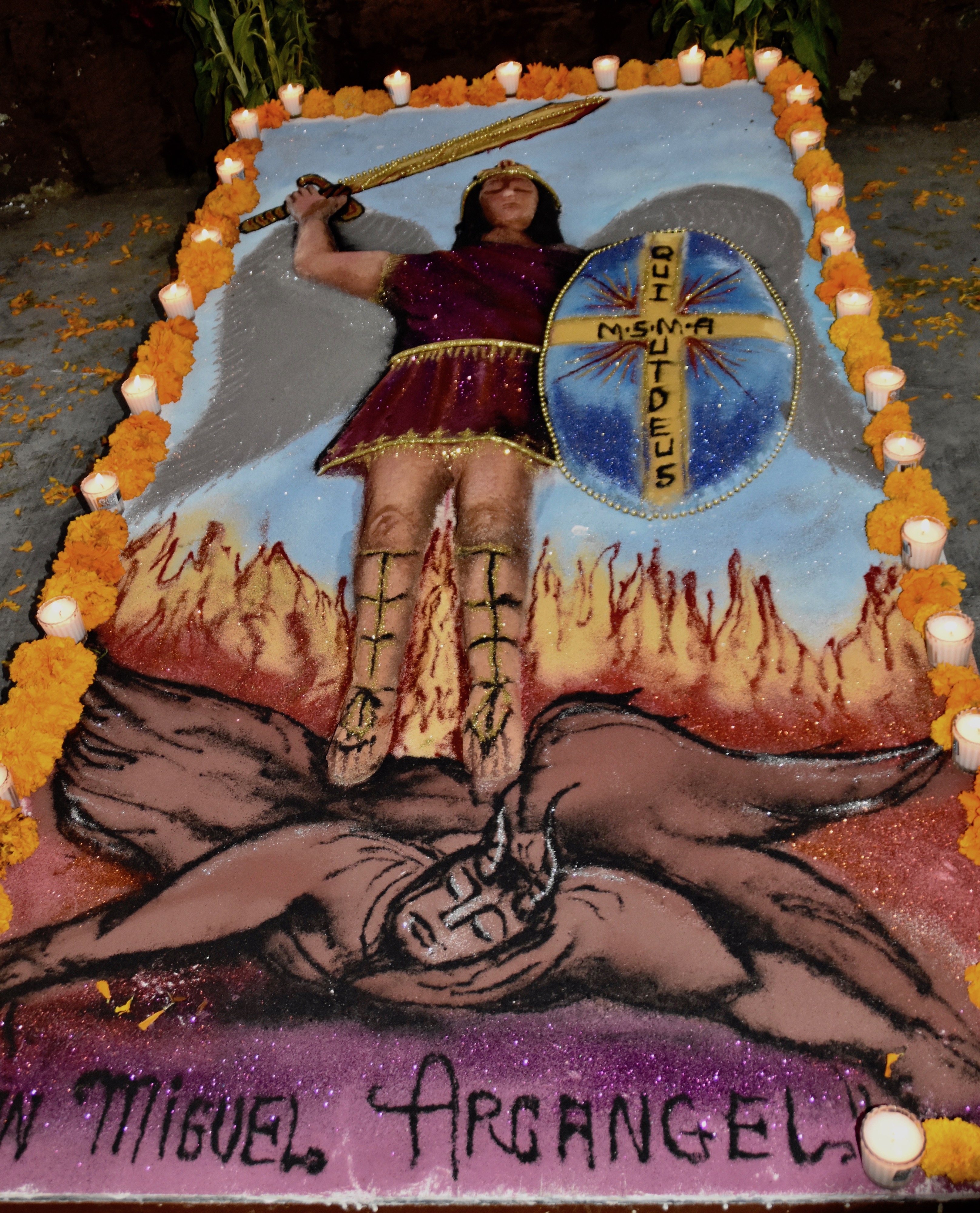
After an hour or so we moved on from the New Cemetery to the Old Cemetery which was much smaller with the graves much closer together and more compact. Here, people were literally tripping over these grave sites and I saw one woman tourist knock over and break some of glass candle holders on one of the ofrendas.
She didn’t even bother to apologize and I was glad to see she wasn’t one of our small group. Also, a group of Asian tourists were taking pictures of themselves sitting on or leaning over other ofrendas, in some cases only inches away from the people who had built them and were there to spend the night in communion with their dear departed.
Maybe the Mexicans didn’t mind these ignorant intrusions, but I did and unfortunately as global tourism continues to explode, there will be much more of the same in the future. That is one of the reasons I think getting to Oaxaca during the Day of the Dead celebrations sooner rather than later is well advised. If the tourists eventually over shadow the local participants in these festivities, there might not even be a later.
I’m not going to end this post on a down note. Despite my qualms about what some of the other tourists were doing in the Old Cemetery, it was still an incredibly magical place. It was much darker than the New Cemetery and had a more authentic feeling to it. Some of the ofrendas were really amazing, particularly a few that featured tiny figures.

If you look closely you can see that this is a wedding.
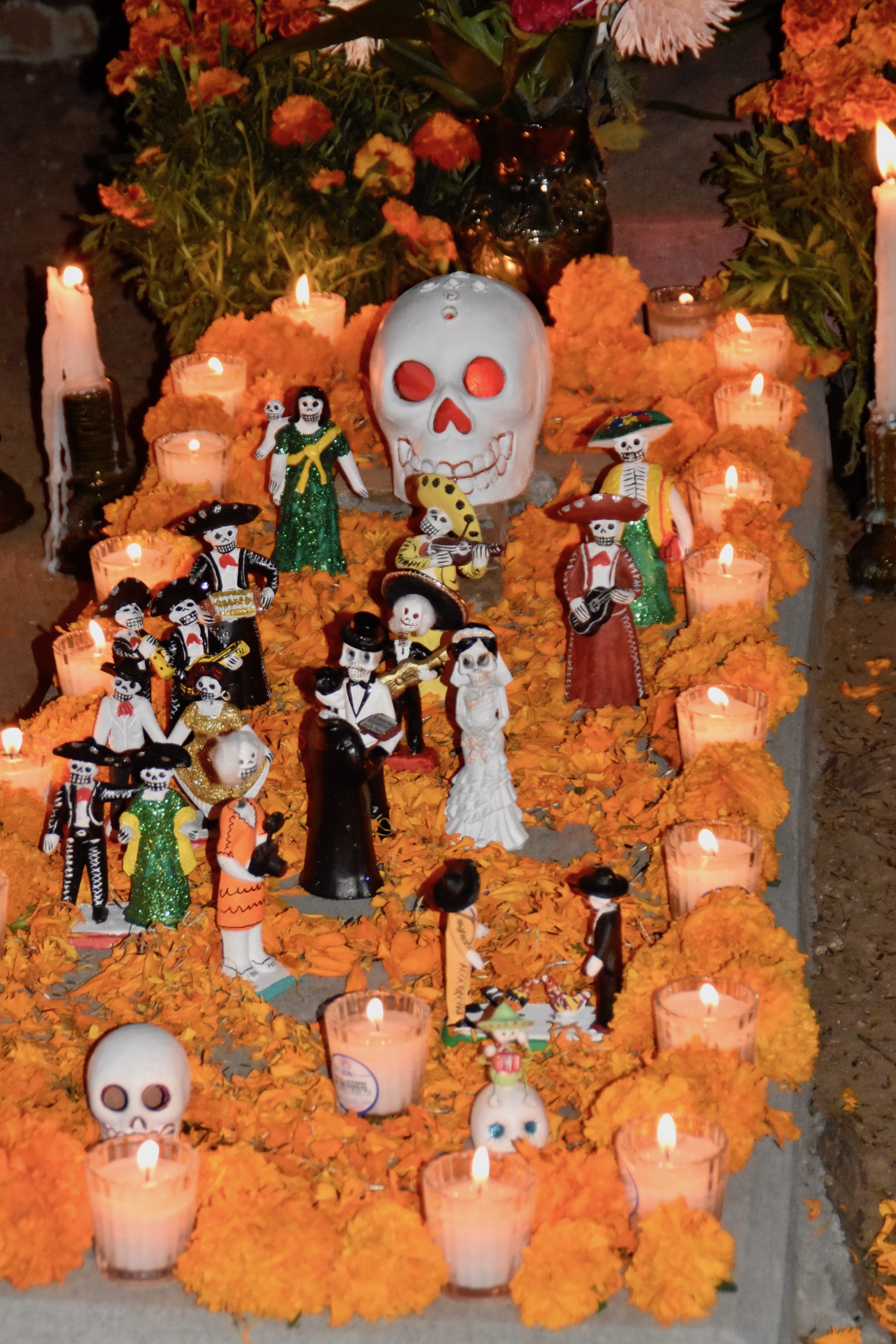
Having now been to Mexico during the Day of the Dead I can understand why the collective experience has been named by UNESCO as an Intangible Heritage that is of value to the entire world. I subtitled this post Mexico’s Unique Celebration fully aware that Day of the Dead celebrations do take place outside of Mexico, but because they did originate in Mexico these, in effect, are the real deal. Accept no substitutes.
Again, many thanks to Dale of The Maritime Explorer for allowing us to share this interesting summary. If you're interested in seeing Mexico in a different way, check out our Mexico tours.
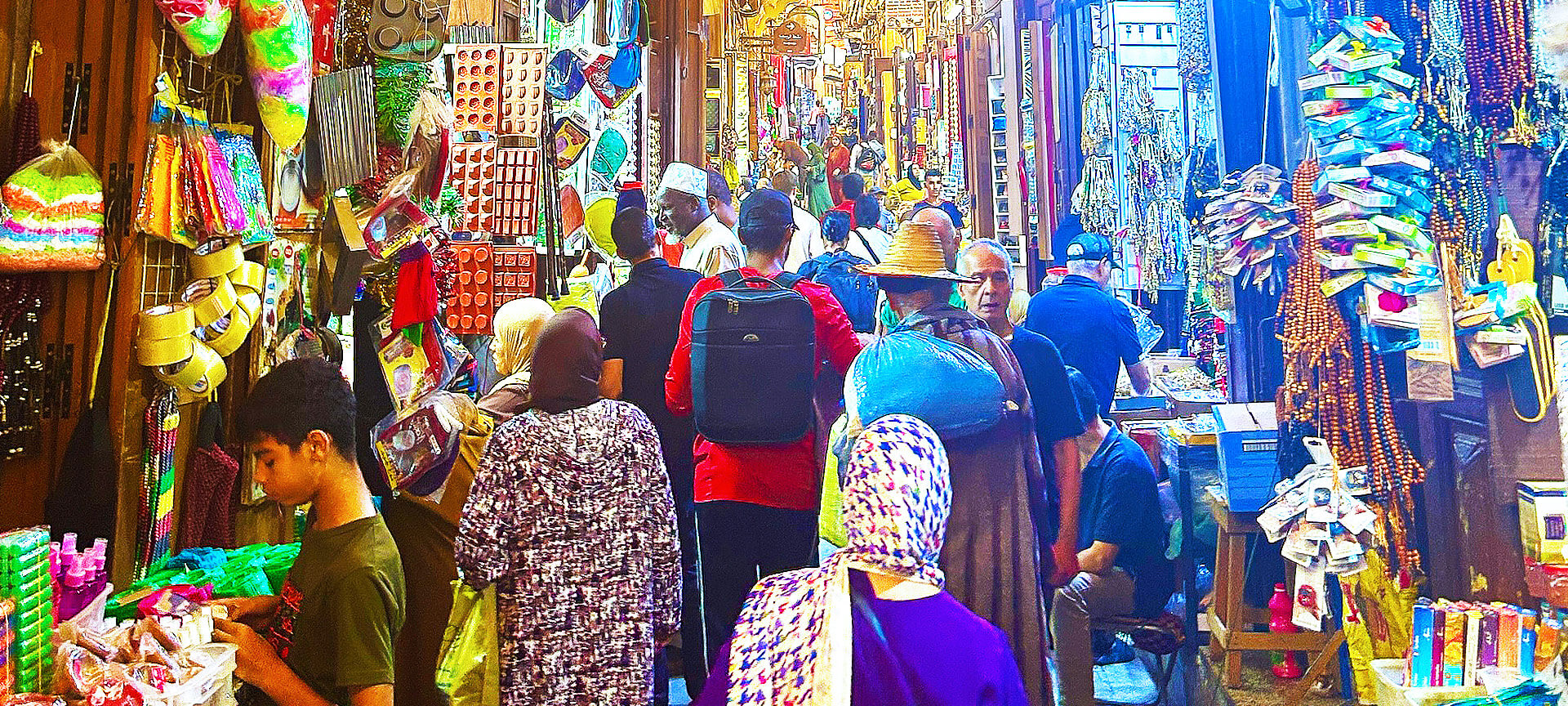
View all
